Photovoltaic Solar Power System Assignment 2022
VerifiedAdded on 2022/09/21
|21
|3747
|135
Assignment
AI Summary
Contribute Materials
Your contribution can guide someone’s learning journey. Share your
documents today.

Running head: PHOTOVOLTAIC SYSTEM 1
Photo-voltaic solar power system
Name
Institution
Photo-voltaic solar power system
Name
Institution
Secure Best Marks with AI Grader
Need help grading? Try our AI Grader for instant feedback on your assignments.
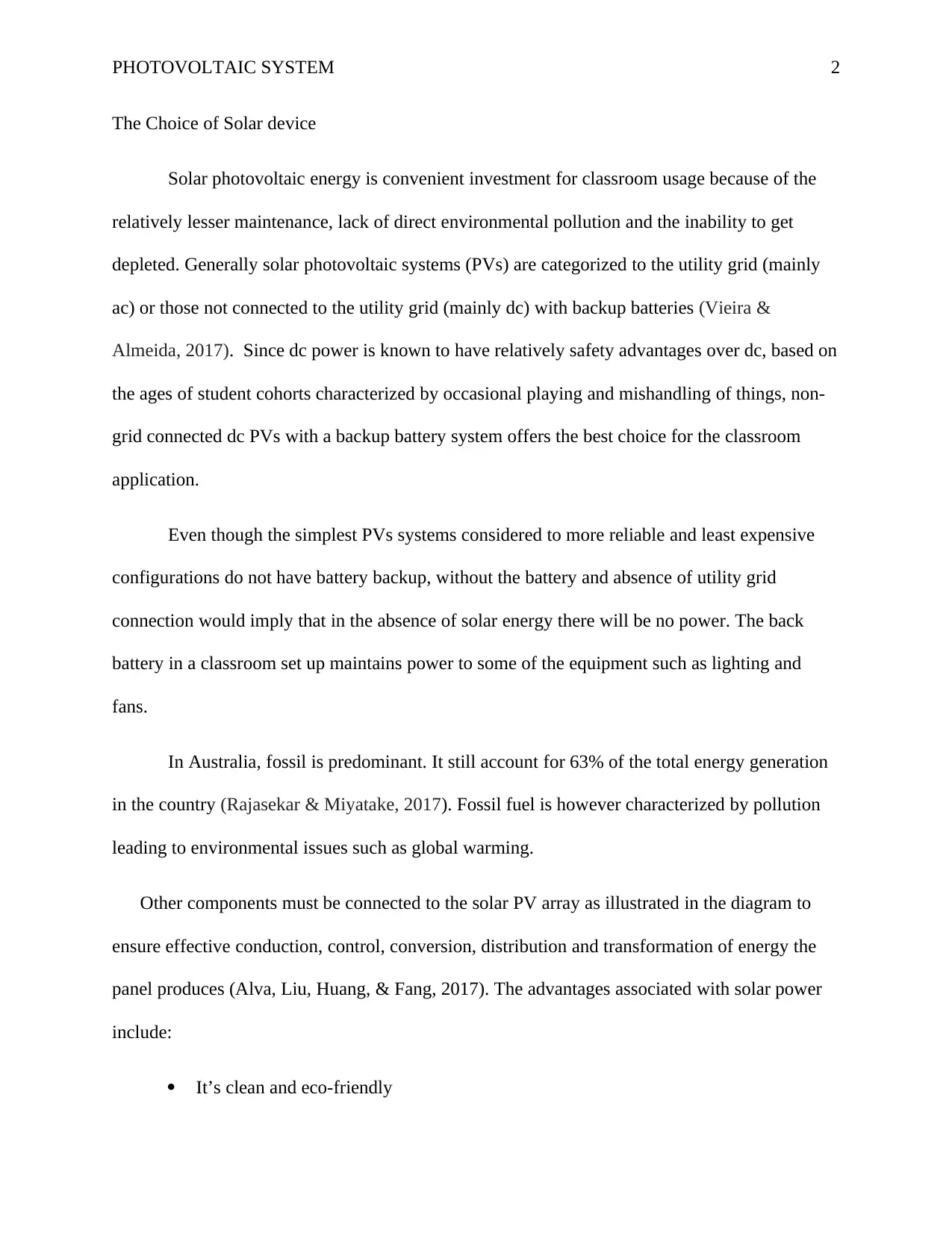
PHOTOVOLTAIC SYSTEM 2
The Choice of Solar device
Solar photovoltaic energy is convenient investment for classroom usage because of the
relatively lesser maintenance, lack of direct environmental pollution and the inability to get
depleted. Generally solar photovoltaic systems (PVs) are categorized to the utility grid (mainly
ac) or those not connected to the utility grid (mainly dc) with backup batteries (Vieira &
Almeida, 2017). Since dc power is known to have relatively safety advantages over dc, based on
the ages of student cohorts characterized by occasional playing and mishandling of things, non-
grid connected dc PVs with a backup battery system offers the best choice for the classroom
application.
Even though the simplest PVs systems considered to more reliable and least expensive
configurations do not have battery backup, without the battery and absence of utility grid
connection would imply that in the absence of solar energy there will be no power. The back
battery in a classroom set up maintains power to some of the equipment such as lighting and
fans.
In Australia, fossil is predominant. It still account for 63% of the total energy generation
in the country (Rajasekar & Miyatake, 2017). Fossil fuel is however characterized by pollution
leading to environmental issues such as global warming.
Other components must be connected to the solar PV array as illustrated in the diagram to
ensure effective conduction, control, conversion, distribution and transformation of energy the
panel produces (Alva, Liu, Huang, & Fang, 2017). The advantages associated with solar power
include:
It’s clean and eco-friendly
The Choice of Solar device
Solar photovoltaic energy is convenient investment for classroom usage because of the
relatively lesser maintenance, lack of direct environmental pollution and the inability to get
depleted. Generally solar photovoltaic systems (PVs) are categorized to the utility grid (mainly
ac) or those not connected to the utility grid (mainly dc) with backup batteries (Vieira &
Almeida, 2017). Since dc power is known to have relatively safety advantages over dc, based on
the ages of student cohorts characterized by occasional playing and mishandling of things, non-
grid connected dc PVs with a backup battery system offers the best choice for the classroom
application.
Even though the simplest PVs systems considered to more reliable and least expensive
configurations do not have battery backup, without the battery and absence of utility grid
connection would imply that in the absence of solar energy there will be no power. The back
battery in a classroom set up maintains power to some of the equipment such as lighting and
fans.
In Australia, fossil is predominant. It still account for 63% of the total energy generation
in the country (Rajasekar & Miyatake, 2017). Fossil fuel is however characterized by pollution
leading to environmental issues such as global warming.
Other components must be connected to the solar PV array as illustrated in the diagram to
ensure effective conduction, control, conversion, distribution and transformation of energy the
panel produces (Alva, Liu, Huang, & Fang, 2017). The advantages associated with solar power
include:
It’s clean and eco-friendly
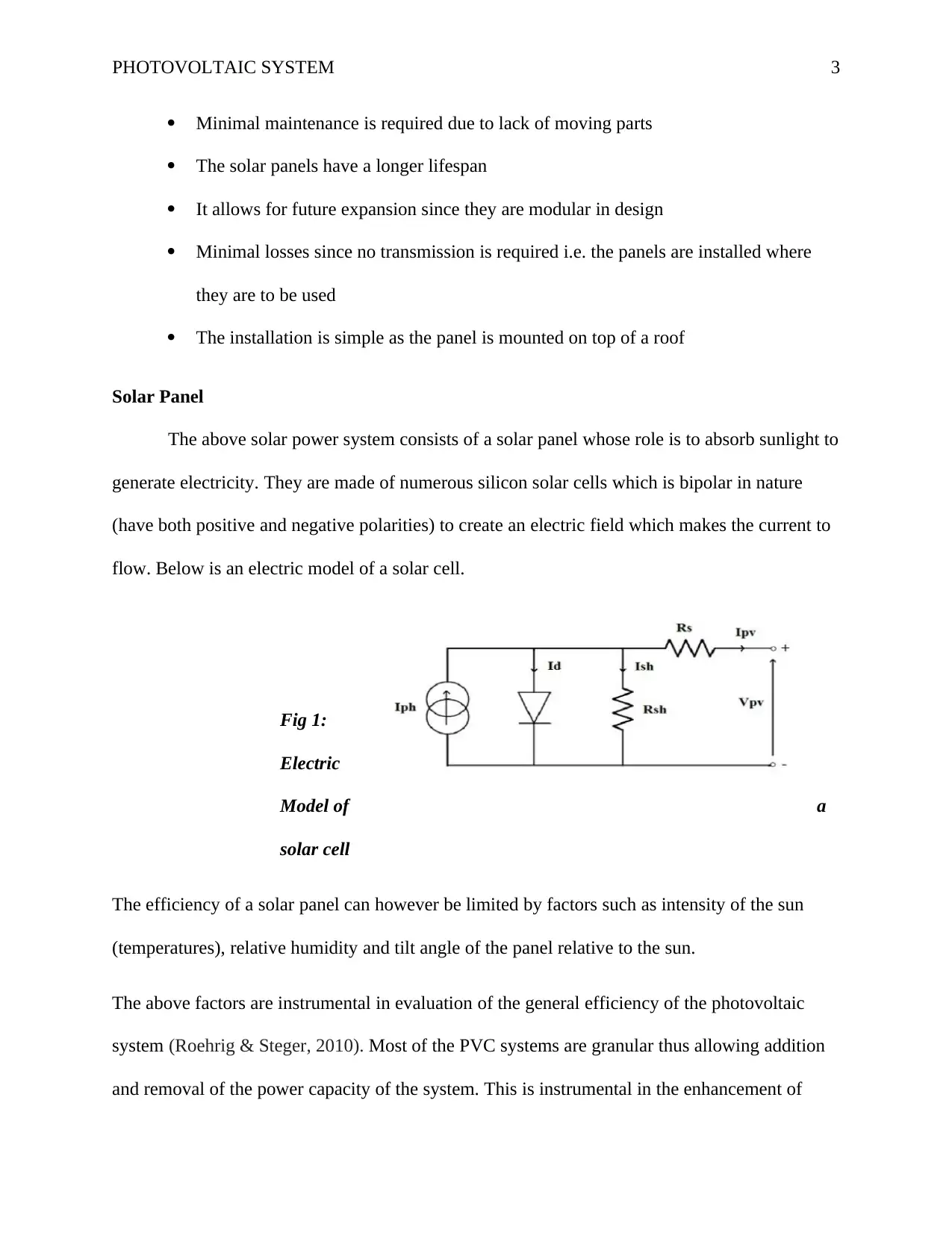
PHOTOVOLTAIC SYSTEM 3
Minimal maintenance is required due to lack of moving parts
The solar panels have a longer lifespan
It allows for future expansion since they are modular in design
Minimal losses since no transmission is required i.e. the panels are installed where
they are to be used
The installation is simple as the panel is mounted on top of a roof
Solar Panel
The above solar power system consists of a solar panel whose role is to absorb sunlight to
generate electricity. They are made of numerous silicon solar cells which is bipolar in nature
(have both positive and negative polarities) to create an electric field which makes the current to
flow. Below is an electric model of a solar cell.
Fig 1:
Electric
Model of a
solar cell
The efficiency of a solar panel can however be limited by factors such as intensity of the sun
(temperatures), relative humidity and tilt angle of the panel relative to the sun.
The above factors are instrumental in evaluation of the general efficiency of the photovoltaic
system (Roehrig & Steger, 2010). Most of the PVC systems are granular thus allowing addition
and removal of the power capacity of the system. This is instrumental in the enhancement of
Minimal maintenance is required due to lack of moving parts
The solar panels have a longer lifespan
It allows for future expansion since they are modular in design
Minimal losses since no transmission is required i.e. the panels are installed where
they are to be used
The installation is simple as the panel is mounted on top of a roof
Solar Panel
The above solar power system consists of a solar panel whose role is to absorb sunlight to
generate electricity. They are made of numerous silicon solar cells which is bipolar in nature
(have both positive and negative polarities) to create an electric field which makes the current to
flow. Below is an electric model of a solar cell.
Fig 1:
Electric
Model of a
solar cell
The efficiency of a solar panel can however be limited by factors such as intensity of the sun
(temperatures), relative humidity and tilt angle of the panel relative to the sun.
The above factors are instrumental in evaluation of the general efficiency of the photovoltaic
system (Roehrig & Steger, 2010). Most of the PVC systems are granular thus allowing addition
and removal of the power capacity of the system. This is instrumental in the enhancement of
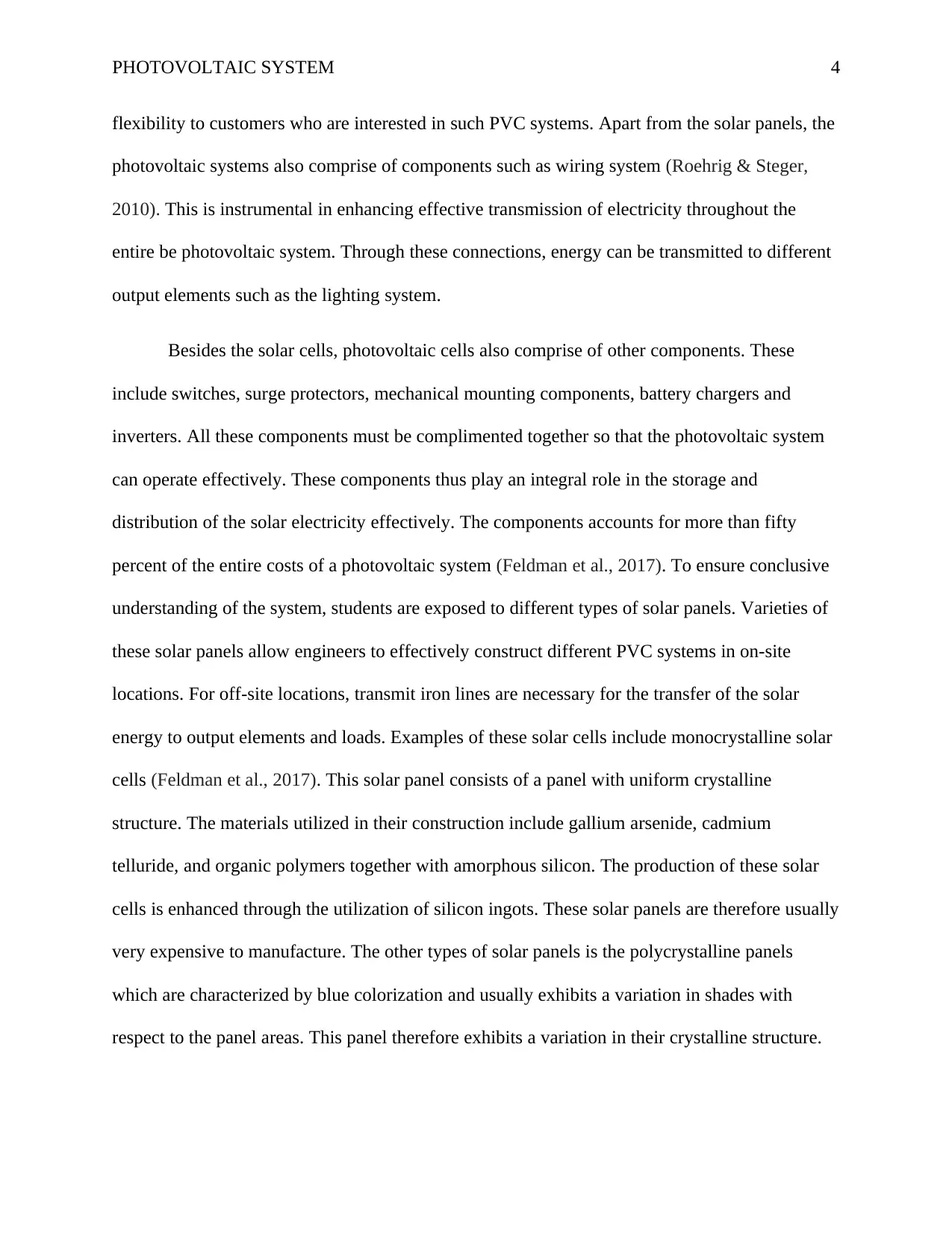
PHOTOVOLTAIC SYSTEM 4
flexibility to customers who are interested in such PVC systems. Apart from the solar panels, the
photovoltaic systems also comprise of components such as wiring system (Roehrig & Steger,
2010). This is instrumental in enhancing effective transmission of electricity throughout the
entire be photovoltaic system. Through these connections, energy can be transmitted to different
output elements such as the lighting system.
Besides the solar cells, photovoltaic cells also comprise of other components. These
include switches, surge protectors, mechanical mounting components, battery chargers and
inverters. All these components must be complimented together so that the photovoltaic system
can operate effectively. These components thus play an integral role in the storage and
distribution of the solar electricity effectively. The components accounts for more than fifty
percent of the entire costs of a photovoltaic system (Feldman et al., 2017). To ensure conclusive
understanding of the system, students are exposed to different types of solar panels. Varieties of
these solar panels allow engineers to effectively construct different PVC systems in on-site
locations. For off-site locations, transmit iron lines are necessary for the transfer of the solar
energy to output elements and loads. Examples of these solar cells include monocrystalline solar
cells (Feldman et al., 2017). This solar panel consists of a panel with uniform crystalline
structure. The materials utilized in their construction include gallium arsenide, cadmium
telluride, and organic polymers together with amorphous silicon. The production of these solar
cells is enhanced through the utilization of silicon ingots. These solar panels are therefore usually
very expensive to manufacture. The other types of solar panels is the polycrystalline panels
which are characterized by blue colorization and usually exhibits a variation in shades with
respect to the panel areas. This panel therefore exhibits a variation in their crystalline structure.
flexibility to customers who are interested in such PVC systems. Apart from the solar panels, the
photovoltaic systems also comprise of components such as wiring system (Roehrig & Steger,
2010). This is instrumental in enhancing effective transmission of electricity throughout the
entire be photovoltaic system. Through these connections, energy can be transmitted to different
output elements such as the lighting system.
Besides the solar cells, photovoltaic cells also comprise of other components. These
include switches, surge protectors, mechanical mounting components, battery chargers and
inverters. All these components must be complimented together so that the photovoltaic system
can operate effectively. These components thus play an integral role in the storage and
distribution of the solar electricity effectively. The components accounts for more than fifty
percent of the entire costs of a photovoltaic system (Feldman et al., 2017). To ensure conclusive
understanding of the system, students are exposed to different types of solar panels. Varieties of
these solar panels allow engineers to effectively construct different PVC systems in on-site
locations. For off-site locations, transmit iron lines are necessary for the transfer of the solar
energy to output elements and loads. Examples of these solar cells include monocrystalline solar
cells (Feldman et al., 2017). This solar panel consists of a panel with uniform crystalline
structure. The materials utilized in their construction include gallium arsenide, cadmium
telluride, and organic polymers together with amorphous silicon. The production of these solar
cells is enhanced through the utilization of silicon ingots. These solar panels are therefore usually
very expensive to manufacture. The other types of solar panels is the polycrystalline panels
which are characterized by blue colorization and usually exhibits a variation in shades with
respect to the panel areas. This panel therefore exhibits a variation in their crystalline structure.
Secure Best Marks with AI Grader
Need help grading? Try our AI Grader for instant feedback on your assignments.
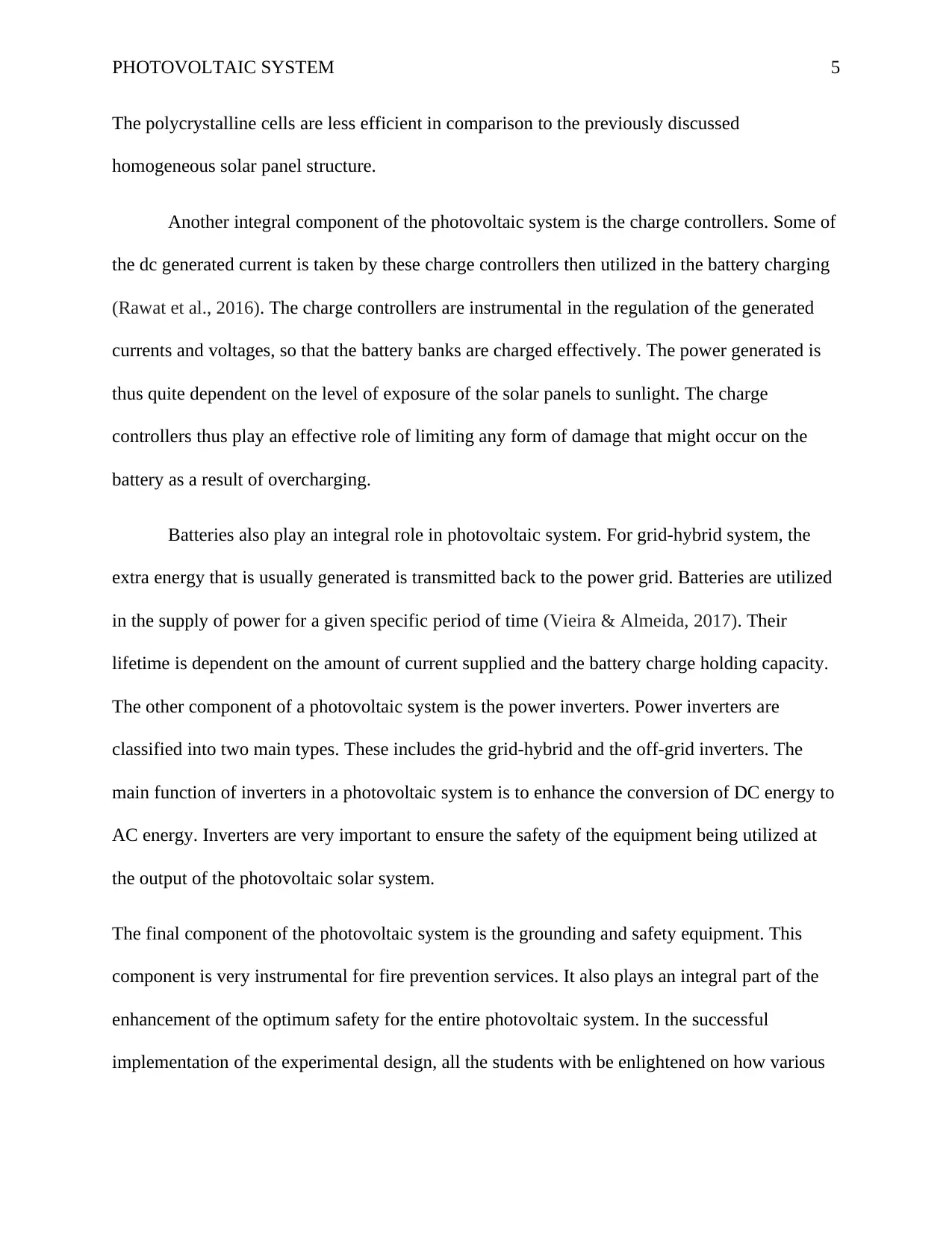
PHOTOVOLTAIC SYSTEM 5
The polycrystalline cells are less efficient in comparison to the previously discussed
homogeneous solar panel structure.
Another integral component of the photovoltaic system is the charge controllers. Some of
the dc generated current is taken by these charge controllers then utilized in the battery charging
(Rawat et al., 2016). The charge controllers are instrumental in the regulation of the generated
currents and voltages, so that the battery banks are charged effectively. The power generated is
thus quite dependent on the level of exposure of the solar panels to sunlight. The charge
controllers thus play an effective role of limiting any form of damage that might occur on the
battery as a result of overcharging.
Batteries also play an integral role in photovoltaic system. For grid-hybrid system, the
extra energy that is usually generated is transmitted back to the power grid. Batteries are utilized
in the supply of power for a given specific period of time (Vieira & Almeida, 2017). Their
lifetime is dependent on the amount of current supplied and the battery charge holding capacity.
The other component of a photovoltaic system is the power inverters. Power inverters are
classified into two main types. These includes the grid-hybrid and the off-grid inverters. The
main function of inverters in a photovoltaic system is to enhance the conversion of DC energy to
AC energy. Inverters are very important to ensure the safety of the equipment being utilized at
the output of the photovoltaic solar system.
The final component of the photovoltaic system is the grounding and safety equipment. This
component is very instrumental for fire prevention services. It also plays an integral part of the
enhancement of the optimum safety for the entire photovoltaic system. In the successful
implementation of the experimental design, all the students with be enlightened on how various
The polycrystalline cells are less efficient in comparison to the previously discussed
homogeneous solar panel structure.
Another integral component of the photovoltaic system is the charge controllers. Some of
the dc generated current is taken by these charge controllers then utilized in the battery charging
(Rawat et al., 2016). The charge controllers are instrumental in the regulation of the generated
currents and voltages, so that the battery banks are charged effectively. The power generated is
thus quite dependent on the level of exposure of the solar panels to sunlight. The charge
controllers thus play an effective role of limiting any form of damage that might occur on the
battery as a result of overcharging.
Batteries also play an integral role in photovoltaic system. For grid-hybrid system, the
extra energy that is usually generated is transmitted back to the power grid. Batteries are utilized
in the supply of power for a given specific period of time (Vieira & Almeida, 2017). Their
lifetime is dependent on the amount of current supplied and the battery charge holding capacity.
The other component of a photovoltaic system is the power inverters. Power inverters are
classified into two main types. These includes the grid-hybrid and the off-grid inverters. The
main function of inverters in a photovoltaic system is to enhance the conversion of DC energy to
AC energy. Inverters are very important to ensure the safety of the equipment being utilized at
the output of the photovoltaic solar system.
The final component of the photovoltaic system is the grounding and safety equipment. This
component is very instrumental for fire prevention services. It also plays an integral part of the
enhancement of the optimum safety for the entire photovoltaic system. In the successful
implementation of the experimental design, all the students with be enlightened on how various
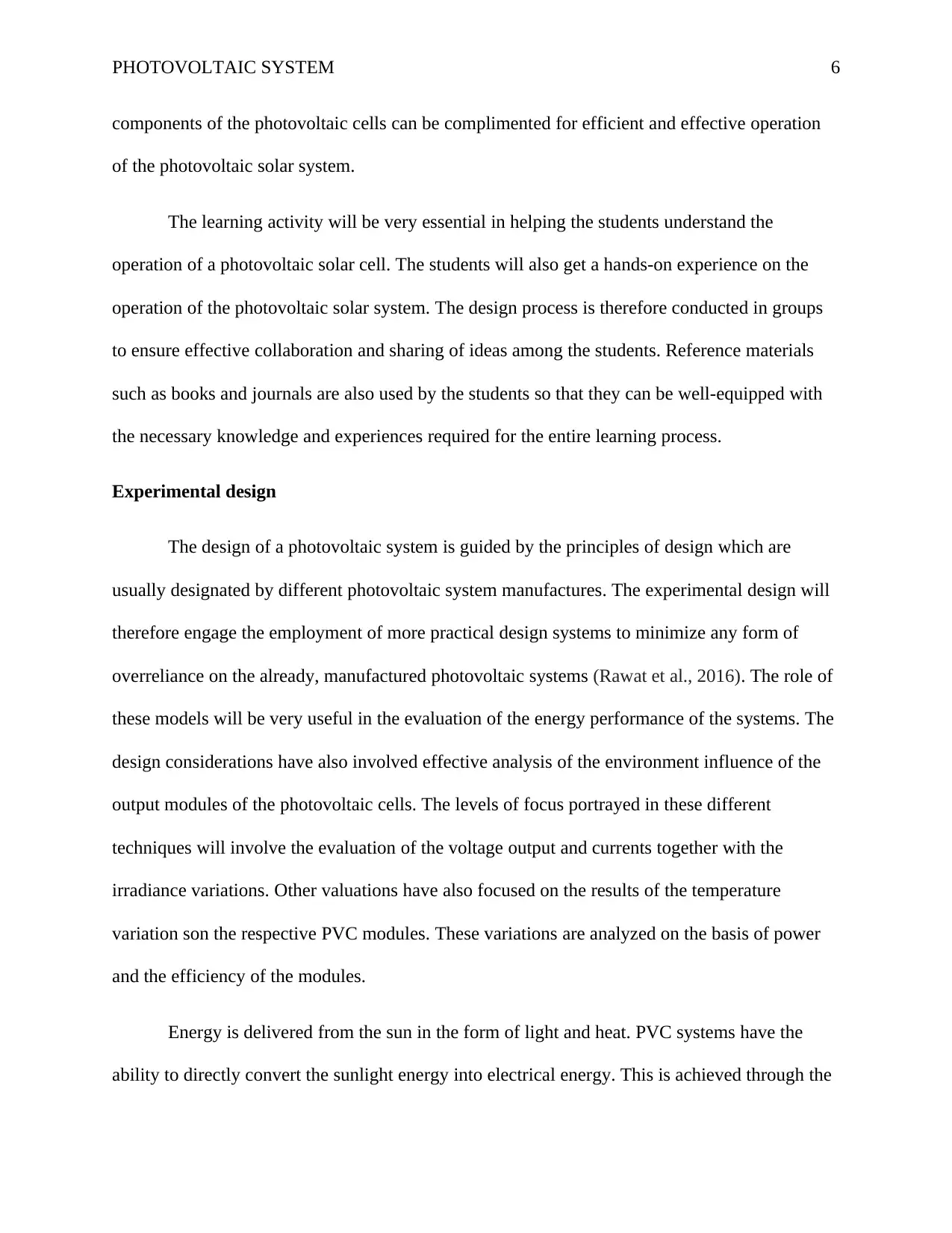
PHOTOVOLTAIC SYSTEM 6
components of the photovoltaic cells can be complimented for efficient and effective operation
of the photovoltaic solar system.
The learning activity will be very essential in helping the students understand the
operation of a photovoltaic solar cell. The students will also get a hands-on experience on the
operation of the photovoltaic solar system. The design process is therefore conducted in groups
to ensure effective collaboration and sharing of ideas among the students. Reference materials
such as books and journals are also used by the students so that they can be well-equipped with
the necessary knowledge and experiences required for the entire learning process.
Experimental design
The design of a photovoltaic system is guided by the principles of design which are
usually designated by different photovoltaic system manufactures. The experimental design will
therefore engage the employment of more practical design systems to minimize any form of
overreliance on the already, manufactured photovoltaic systems (Rawat et al., 2016). The role of
these models will be very useful in the evaluation of the energy performance of the systems. The
design considerations have also involved effective analysis of the environment influence of the
output modules of the photovoltaic cells. The levels of focus portrayed in these different
techniques will involve the evaluation of the voltage output and currents together with the
irradiance variations. Other valuations have also focused on the results of the temperature
variation son the respective PVC modules. These variations are analyzed on the basis of power
and the efficiency of the modules.
Energy is delivered from the sun in the form of light and heat. PVC systems have the
ability to directly convert the sunlight energy into electrical energy. This is achieved through the
components of the photovoltaic cells can be complimented for efficient and effective operation
of the photovoltaic solar system.
The learning activity will be very essential in helping the students understand the
operation of a photovoltaic solar cell. The students will also get a hands-on experience on the
operation of the photovoltaic solar system. The design process is therefore conducted in groups
to ensure effective collaboration and sharing of ideas among the students. Reference materials
such as books and journals are also used by the students so that they can be well-equipped with
the necessary knowledge and experiences required for the entire learning process.
Experimental design
The design of a photovoltaic system is guided by the principles of design which are
usually designated by different photovoltaic system manufactures. The experimental design will
therefore engage the employment of more practical design systems to minimize any form of
overreliance on the already, manufactured photovoltaic systems (Rawat et al., 2016). The role of
these models will be very useful in the evaluation of the energy performance of the systems. The
design considerations have also involved effective analysis of the environment influence of the
output modules of the photovoltaic cells. The levels of focus portrayed in these different
techniques will involve the evaluation of the voltage output and currents together with the
irradiance variations. Other valuations have also focused on the results of the temperature
variation son the respective PVC modules. These variations are analyzed on the basis of power
and the efficiency of the modules.
Energy is delivered from the sun in the form of light and heat. PVC systems have the
ability to directly convert the sunlight energy into electrical energy. This is achieved through the
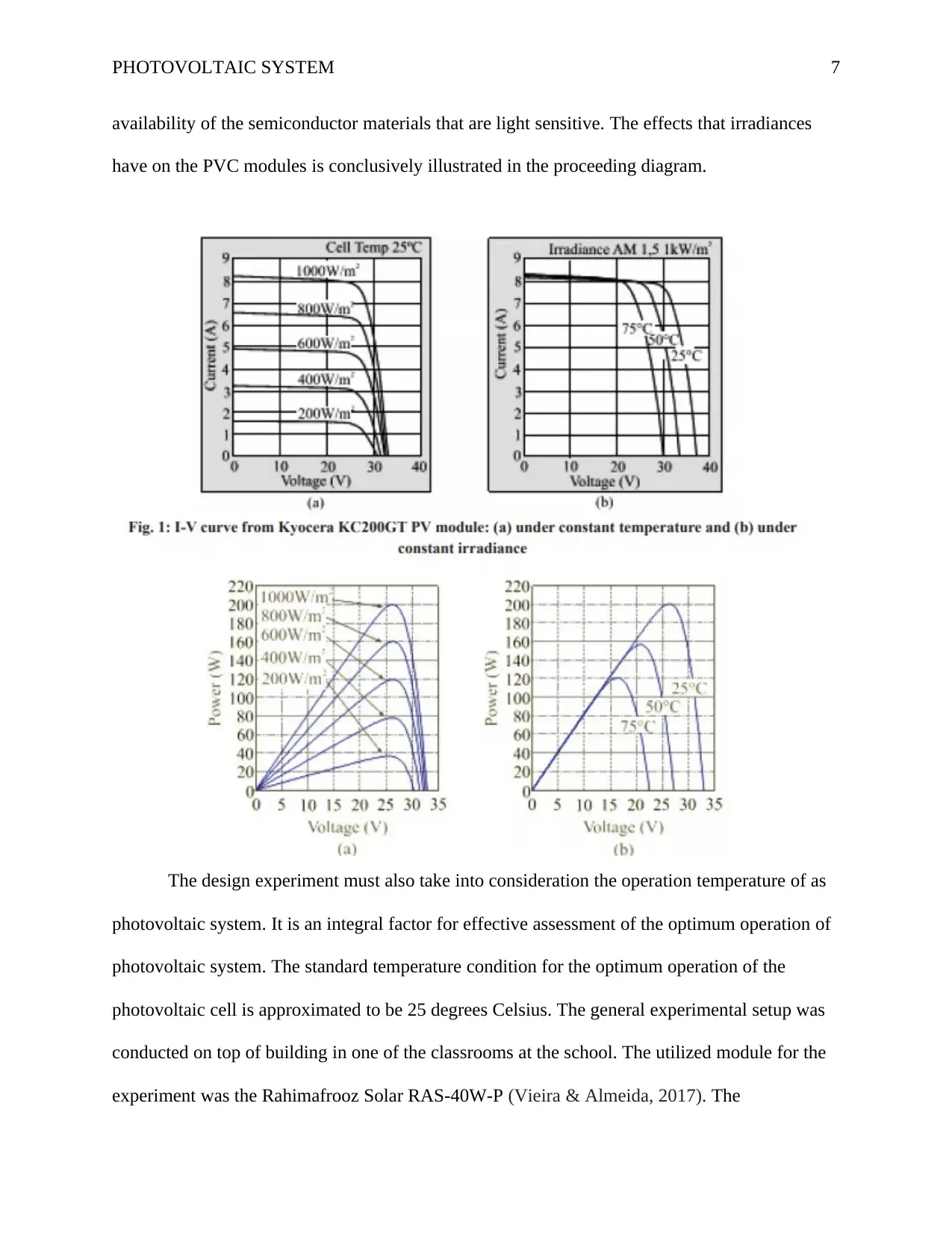
PHOTOVOLTAIC SYSTEM 7
availability of the semiconductor materials that are light sensitive. The effects that irradiances
have on the PVC modules is conclusively illustrated in the proceeding diagram.
The design experiment must also take into consideration the operation temperature of as
photovoltaic system. It is an integral factor for effective assessment of the optimum operation of
photovoltaic system. The standard temperature condition for the optimum operation of the
photovoltaic cell is approximated to be 25 degrees Celsius. The general experimental setup was
conducted on top of building in one of the classrooms at the school. The utilized module for the
experiment was the Rahimafrooz Solar RAS-40W-P (Vieira & Almeida, 2017). The
availability of the semiconductor materials that are light sensitive. The effects that irradiances
have on the PVC modules is conclusively illustrated in the proceeding diagram.
The design experiment must also take into consideration the operation temperature of as
photovoltaic system. It is an integral factor for effective assessment of the optimum operation of
photovoltaic system. The standard temperature condition for the optimum operation of the
photovoltaic cell is approximated to be 25 degrees Celsius. The general experimental setup was
conducted on top of building in one of the classrooms at the school. The utilized module for the
experiment was the Rahimafrooz Solar RAS-40W-P (Vieira & Almeida, 2017). The
Paraphrase This Document
Need a fresh take? Get an instant paraphrase of this document with our AI Paraphraser
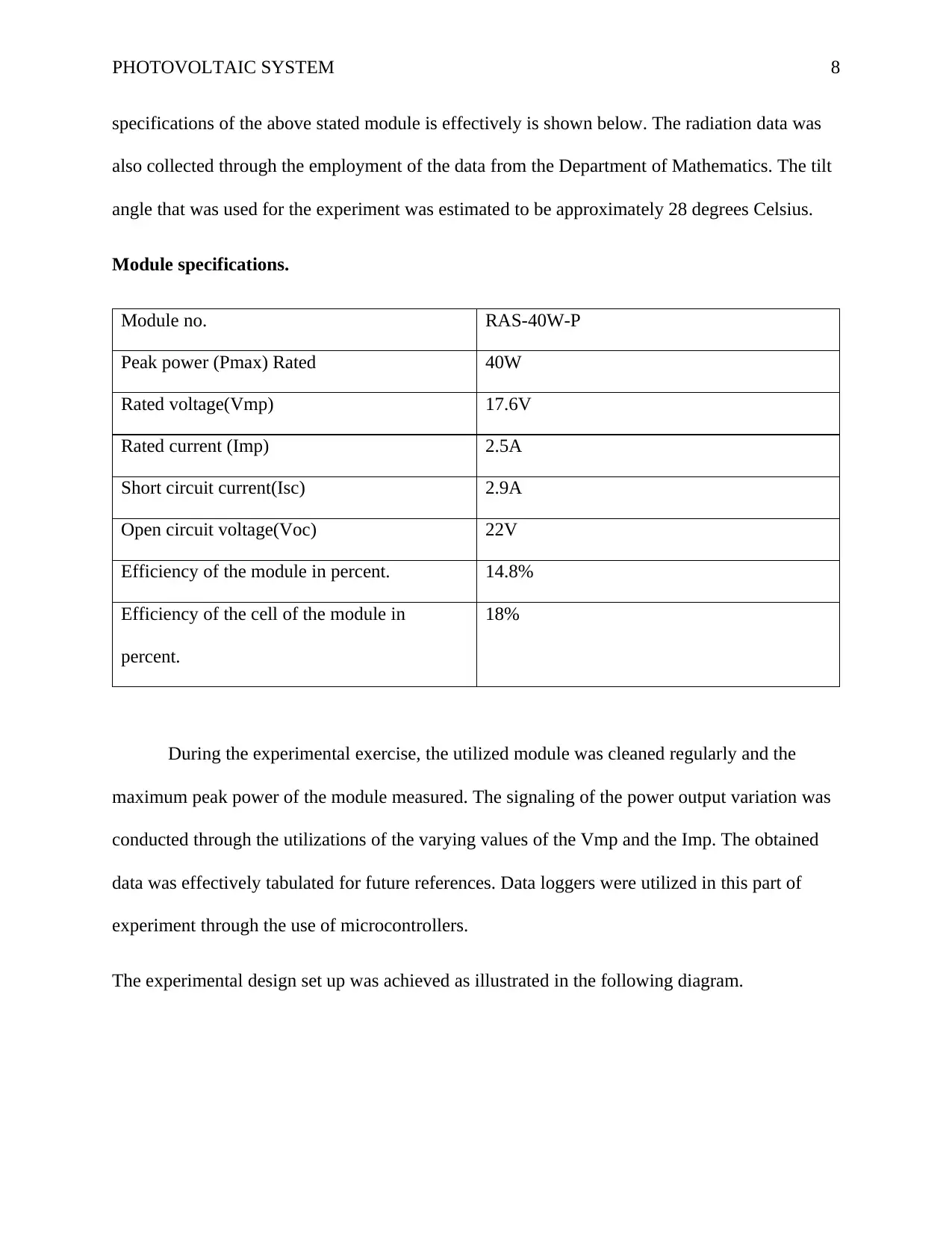
PHOTOVOLTAIC SYSTEM 8
specifications of the above stated module is effectively is shown below. The radiation data was
also collected through the employment of the data from the Department of Mathematics. The tilt
angle that was used for the experiment was estimated to be approximately 28 degrees Celsius.
Module specifications.
Module no. RAS-40W-P
Peak power (Pmax) Rated 40W
Rated voltage(Vmp) 17.6V
Rated current (Imp) 2.5A
Short circuit current(Isc) 2.9A
Open circuit voltage(Voc) 22V
Efficiency of the module in percent. 14.8%
Efficiency of the cell of the module in
percent.
18%
During the experimental exercise, the utilized module was cleaned regularly and the
maximum peak power of the module measured. The signaling of the power output variation was
conducted through the utilizations of the varying values of the Vmp and the Imp. The obtained
data was effectively tabulated for future references. Data loggers were utilized in this part of
experiment through the use of microcontrollers.
The experimental design set up was achieved as illustrated in the following diagram.
specifications of the above stated module is effectively is shown below. The radiation data was
also collected through the employment of the data from the Department of Mathematics. The tilt
angle that was used for the experiment was estimated to be approximately 28 degrees Celsius.
Module specifications.
Module no. RAS-40W-P
Peak power (Pmax) Rated 40W
Rated voltage(Vmp) 17.6V
Rated current (Imp) 2.5A
Short circuit current(Isc) 2.9A
Open circuit voltage(Voc) 22V
Efficiency of the module in percent. 14.8%
Efficiency of the cell of the module in
percent.
18%
During the experimental exercise, the utilized module was cleaned regularly and the
maximum peak power of the module measured. The signaling of the power output variation was
conducted through the utilizations of the varying values of the Vmp and the Imp. The obtained
data was effectively tabulated for future references. Data loggers were utilized in this part of
experiment through the use of microcontrollers.
The experimental design set up was achieved as illustrated in the following diagram.
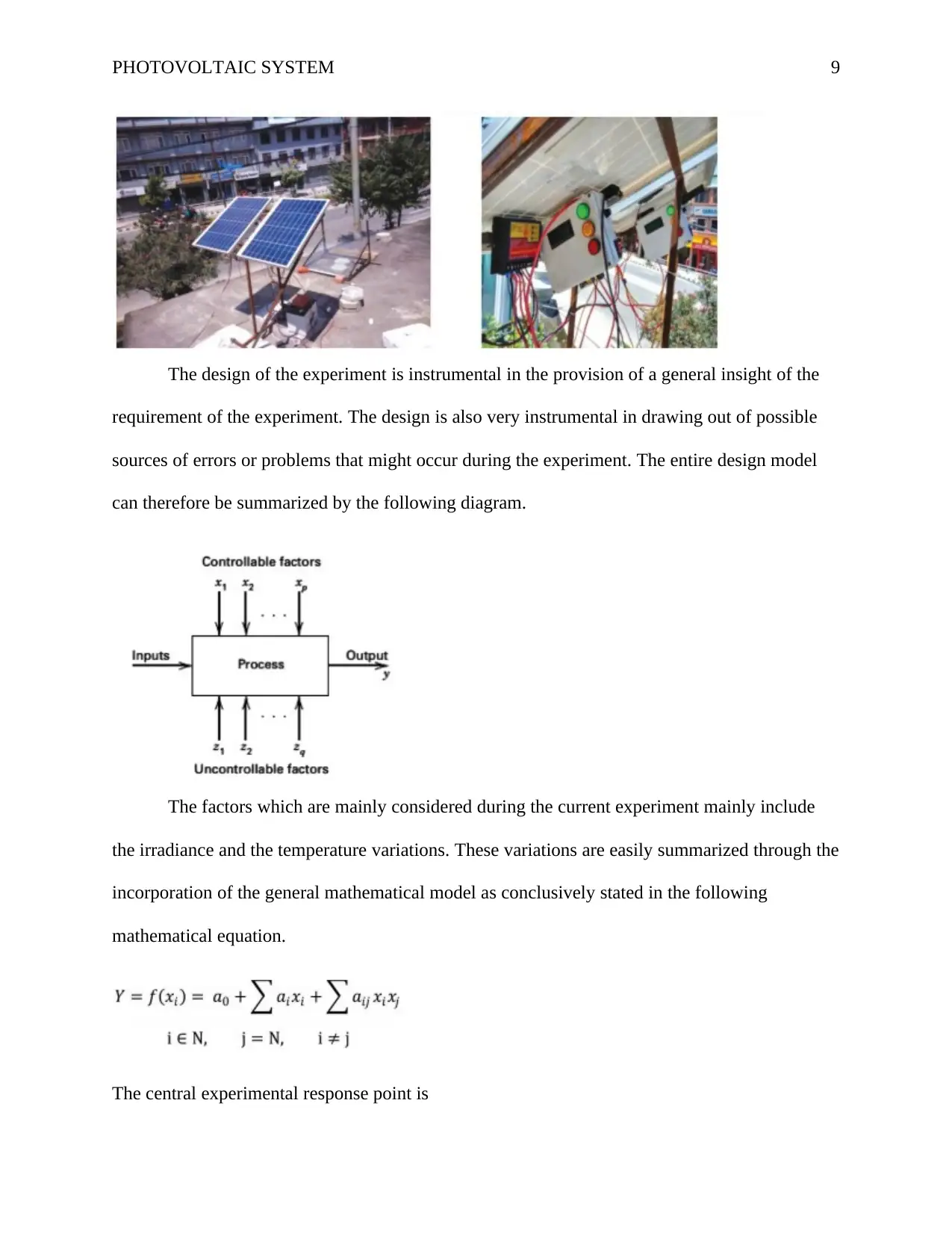
PHOTOVOLTAIC SYSTEM 9
The design of the experiment is instrumental in the provision of a general insight of the
requirement of the experiment. The design is also very instrumental in drawing out of possible
sources of errors or problems that might occur during the experiment. The entire design model
can therefore be summarized by the following diagram.
The factors which are mainly considered during the current experiment mainly include
the irradiance and the temperature variations. These variations are easily summarized through the
incorporation of the general mathematical model as conclusively stated in the following
mathematical equation.
The central experimental response point is
The design of the experiment is instrumental in the provision of a general insight of the
requirement of the experiment. The design is also very instrumental in drawing out of possible
sources of errors or problems that might occur during the experiment. The entire design model
can therefore be summarized by the following diagram.
The factors which are mainly considered during the current experiment mainly include
the irradiance and the temperature variations. These variations are easily summarized through the
incorporation of the general mathematical model as conclusively stated in the following
mathematical equation.
The central experimental response point is
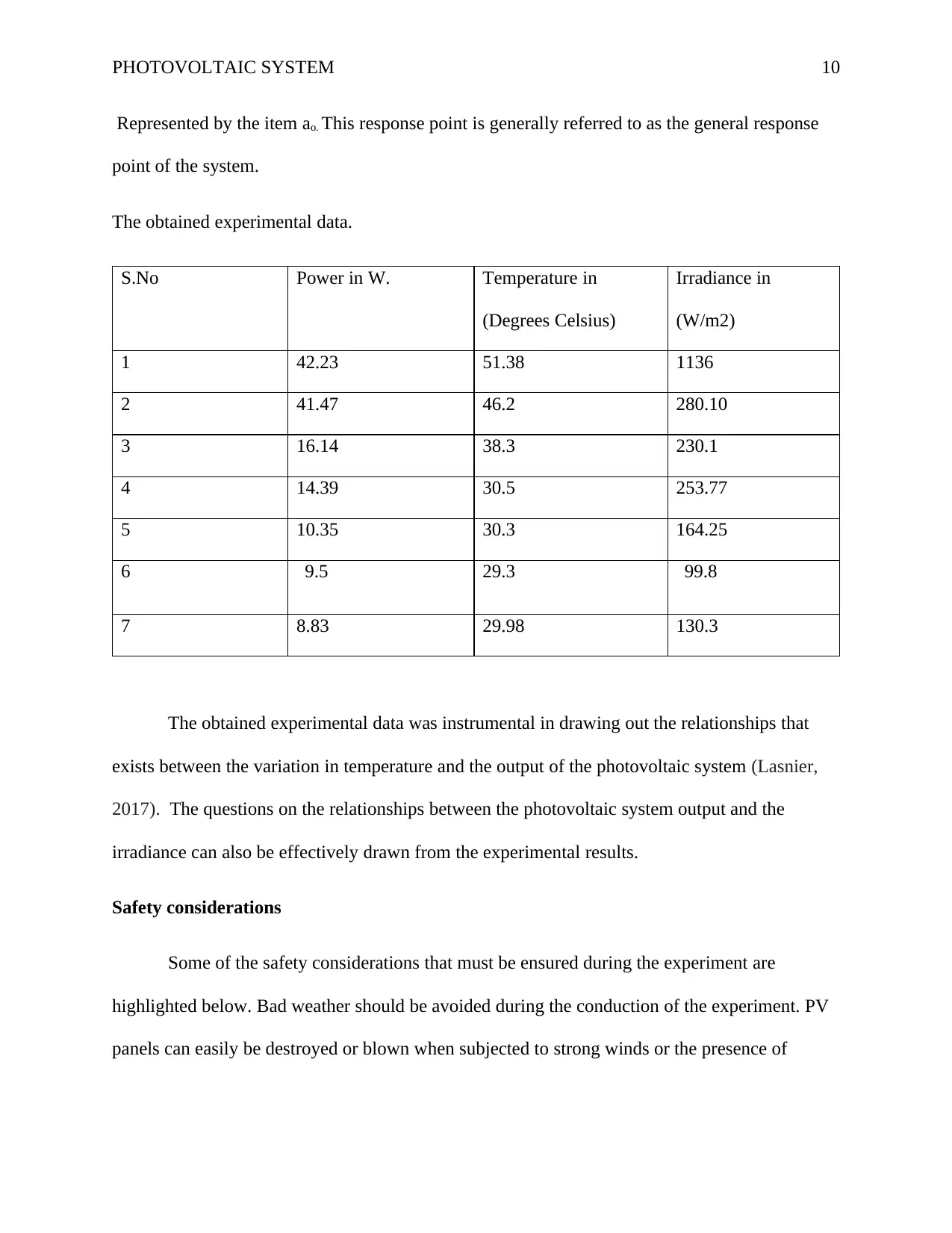
PHOTOVOLTAIC SYSTEM 10
Represented by the item ao. This response point is generally referred to as the general response
point of the system.
The obtained experimental data.
S.No Power in W. Temperature in
(Degrees Celsius)
Irradiance in
(W/m2)
1 42.23 51.38 1136
2 41.47 46.2 280.10
3 16.14 38.3 230.1
4 14.39 30.5 253.77
5 10.35 30.3 164.25
6 9.5 29.3 99.8
7 8.83 29.98 130.3
The obtained experimental data was instrumental in drawing out the relationships that
exists between the variation in temperature and the output of the photovoltaic system (Lasnier,
2017). The questions on the relationships between the photovoltaic system output and the
irradiance can also be effectively drawn from the experimental results.
Safety considerations
Some of the safety considerations that must be ensured during the experiment are
highlighted below. Bad weather should be avoided during the conduction of the experiment. PV
panels can easily be destroyed or blown when subjected to strong winds or the presence of
Represented by the item ao. This response point is generally referred to as the general response
point of the system.
The obtained experimental data.
S.No Power in W. Temperature in
(Degrees Celsius)
Irradiance in
(W/m2)
1 42.23 51.38 1136
2 41.47 46.2 280.10
3 16.14 38.3 230.1
4 14.39 30.5 253.77
5 10.35 30.3 164.25
6 9.5 29.3 99.8
7 8.83 29.98 130.3
The obtained experimental data was instrumental in drawing out the relationships that
exists between the variation in temperature and the output of the photovoltaic system (Lasnier,
2017). The questions on the relationships between the photovoltaic system output and the
irradiance can also be effectively drawn from the experimental results.
Safety considerations
Some of the safety considerations that must be ensured during the experiment are
highlighted below. Bad weather should be avoided during the conduction of the experiment. PV
panels can easily be destroyed or blown when subjected to strong winds or the presence of
Secure Best Marks with AI Grader
Need help grading? Try our AI Grader for instant feedback on your assignments.
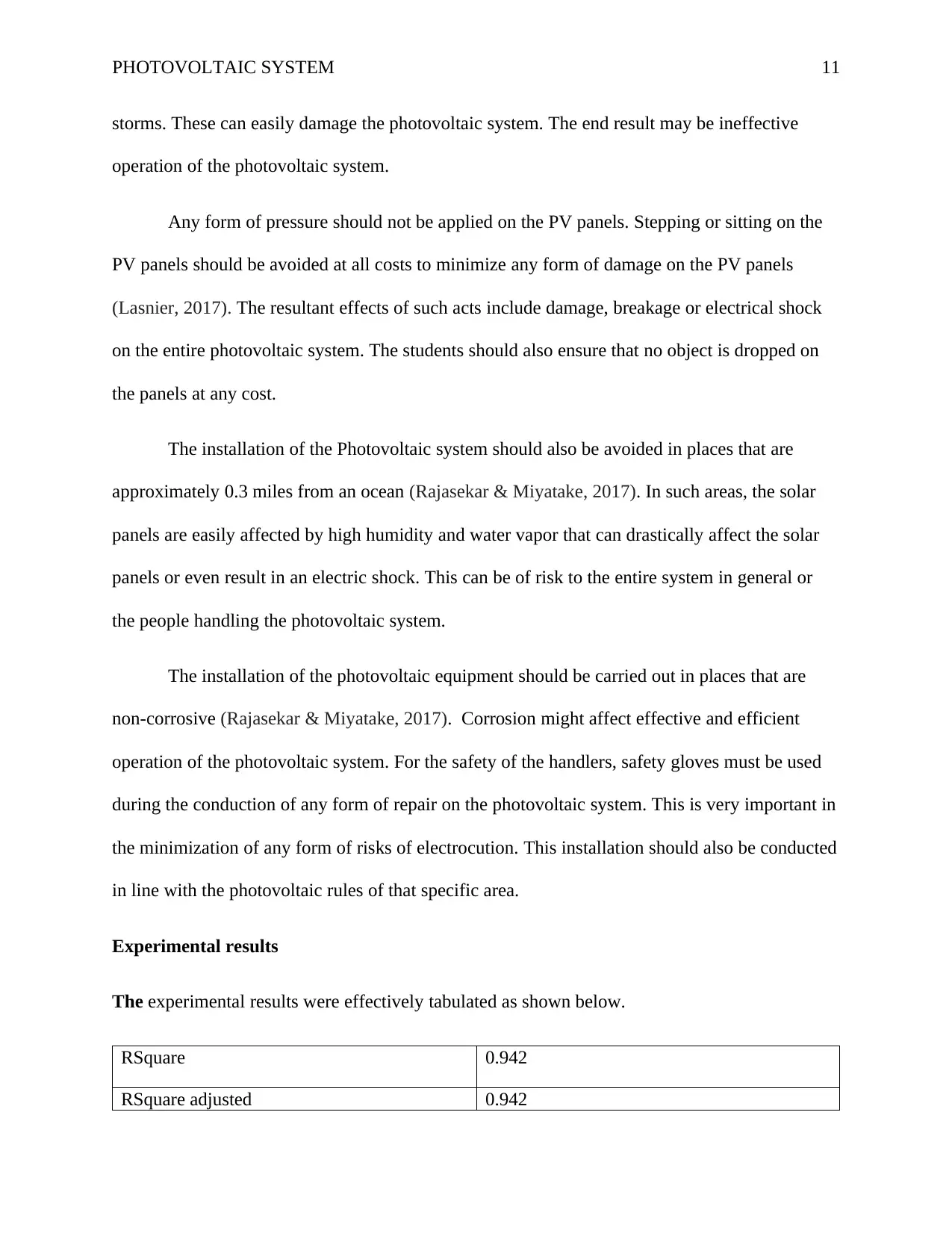
PHOTOVOLTAIC SYSTEM 11
storms. These can easily damage the photovoltaic system. The end result may be ineffective
operation of the photovoltaic system.
Any form of pressure should not be applied on the PV panels. Stepping or sitting on the
PV panels should be avoided at all costs to minimize any form of damage on the PV panels
(Lasnier, 2017). The resultant effects of such acts include damage, breakage or electrical shock
on the entire photovoltaic system. The students should also ensure that no object is dropped on
the panels at any cost.
The installation of the Photovoltaic system should also be avoided in places that are
approximately 0.3 miles from an ocean (Rajasekar & Miyatake, 2017). In such areas, the solar
panels are easily affected by high humidity and water vapor that can drastically affect the solar
panels or even result in an electric shock. This can be of risk to the entire system in general or
the people handling the photovoltaic system.
The installation of the photovoltaic equipment should be carried out in places that are
non-corrosive (Rajasekar & Miyatake, 2017). Corrosion might affect effective and efficient
operation of the photovoltaic system. For the safety of the handlers, safety gloves must be used
during the conduction of any form of repair on the photovoltaic system. This is very important in
the minimization of any form of risks of electrocution. This installation should also be conducted
in line with the photovoltaic rules of that specific area.
Experimental results
The experimental results were effectively tabulated as shown below.
RSquare 0.942
RSquare adjusted 0.942
storms. These can easily damage the photovoltaic system. The end result may be ineffective
operation of the photovoltaic system.
Any form of pressure should not be applied on the PV panels. Stepping or sitting on the
PV panels should be avoided at all costs to minimize any form of damage on the PV panels
(Lasnier, 2017). The resultant effects of such acts include damage, breakage or electrical shock
on the entire photovoltaic system. The students should also ensure that no object is dropped on
the panels at any cost.
The installation of the Photovoltaic system should also be avoided in places that are
approximately 0.3 miles from an ocean (Rajasekar & Miyatake, 2017). In such areas, the solar
panels are easily affected by high humidity and water vapor that can drastically affect the solar
panels or even result in an electric shock. This can be of risk to the entire system in general or
the people handling the photovoltaic system.
The installation of the photovoltaic equipment should be carried out in places that are
non-corrosive (Rajasekar & Miyatake, 2017). Corrosion might affect effective and efficient
operation of the photovoltaic system. For the safety of the handlers, safety gloves must be used
during the conduction of any form of repair on the photovoltaic system. This is very important in
the minimization of any form of risks of electrocution. This installation should also be conducted
in line with the photovoltaic rules of that specific area.
Experimental results
The experimental results were effectively tabulated as shown below.
RSquare 0.942
RSquare adjusted 0.942
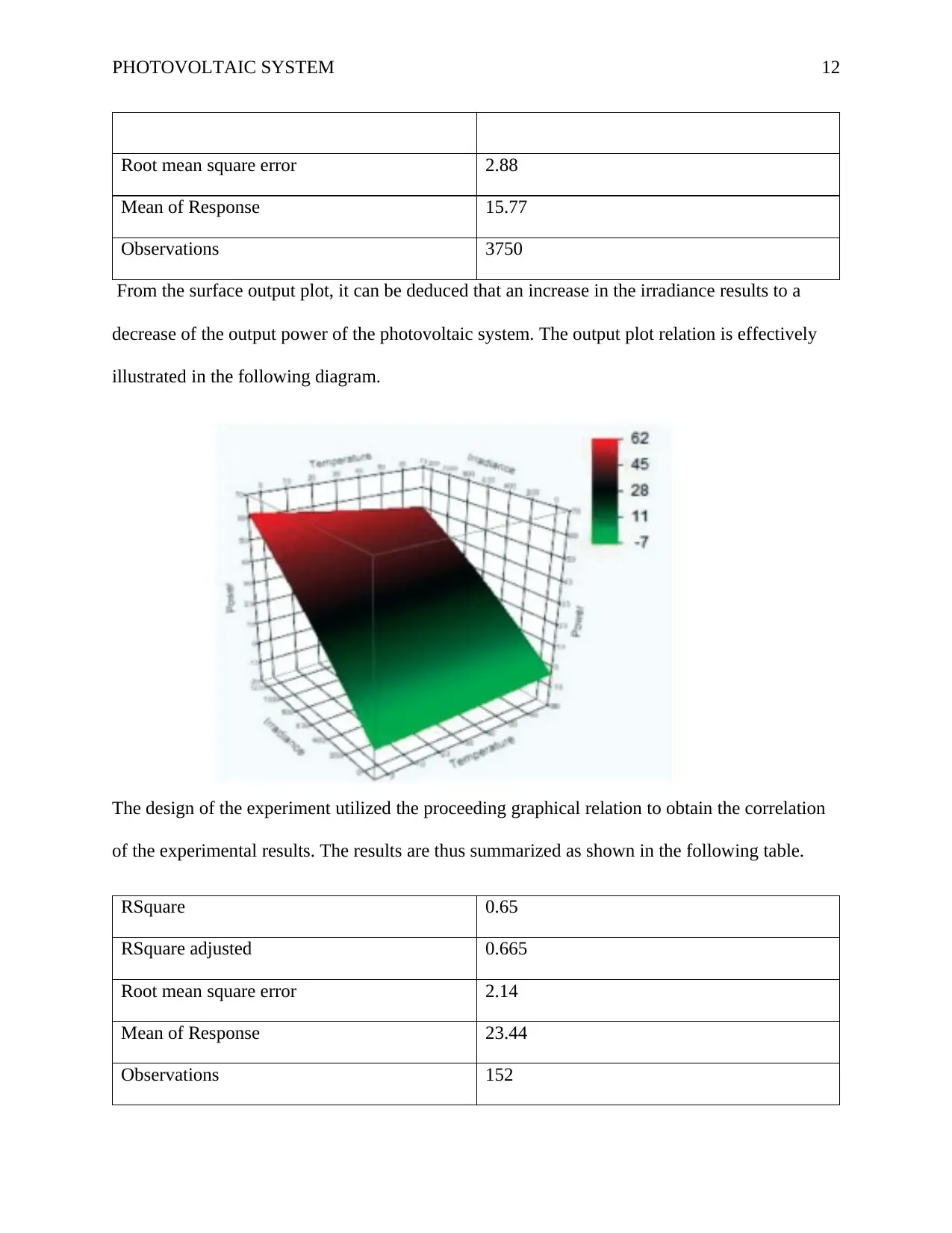
PHOTOVOLTAIC SYSTEM 12
Root mean square error 2.88
Mean of Response 15.77
Observations 3750
From the surface output plot, it can be deduced that an increase in the irradiance results to a
decrease of the output power of the photovoltaic system. The output plot relation is effectively
illustrated in the following diagram.
The design of the experiment utilized the proceeding graphical relation to obtain the correlation
of the experimental results. The results are thus summarized as shown in the following table.
RSquare 0.65
RSquare adjusted 0.665
Root mean square error 2.14
Mean of Response 23.44
Observations 152
Root mean square error 2.88
Mean of Response 15.77
Observations 3750
From the surface output plot, it can be deduced that an increase in the irradiance results to a
decrease of the output power of the photovoltaic system. The output plot relation is effectively
illustrated in the following diagram.
The design of the experiment utilized the proceeding graphical relation to obtain the correlation
of the experimental results. The results are thus summarized as shown in the following table.
RSquare 0.65
RSquare adjusted 0.665
Root mean square error 2.14
Mean of Response 23.44
Observations 152
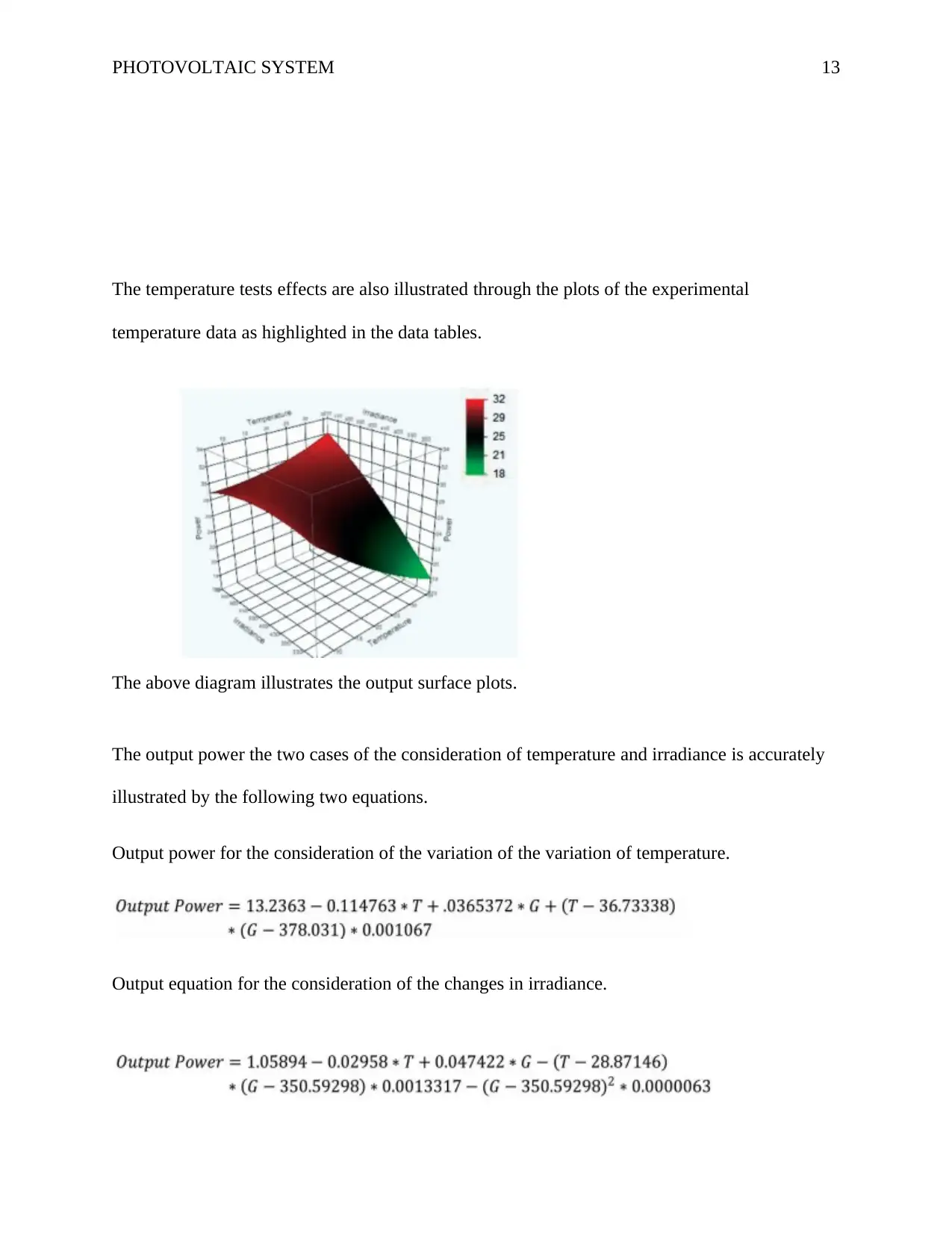
PHOTOVOLTAIC SYSTEM 13
The temperature tests effects are also illustrated through the plots of the experimental
temperature data as highlighted in the data tables.
The above diagram illustrates the output surface plots.
The output power the two cases of the consideration of temperature and irradiance is accurately
illustrated by the following two equations.
Output power for the consideration of the variation of the variation of temperature.
Output equation for the consideration of the changes in irradiance.
The temperature tests effects are also illustrated through the plots of the experimental
temperature data as highlighted in the data tables.
The above diagram illustrates the output surface plots.
The output power the two cases of the consideration of temperature and irradiance is accurately
illustrated by the following two equations.
Output power for the consideration of the variation of the variation of temperature.
Output equation for the consideration of the changes in irradiance.
Paraphrase This Document
Need a fresh take? Get an instant paraphrase of this document with our AI Paraphraser
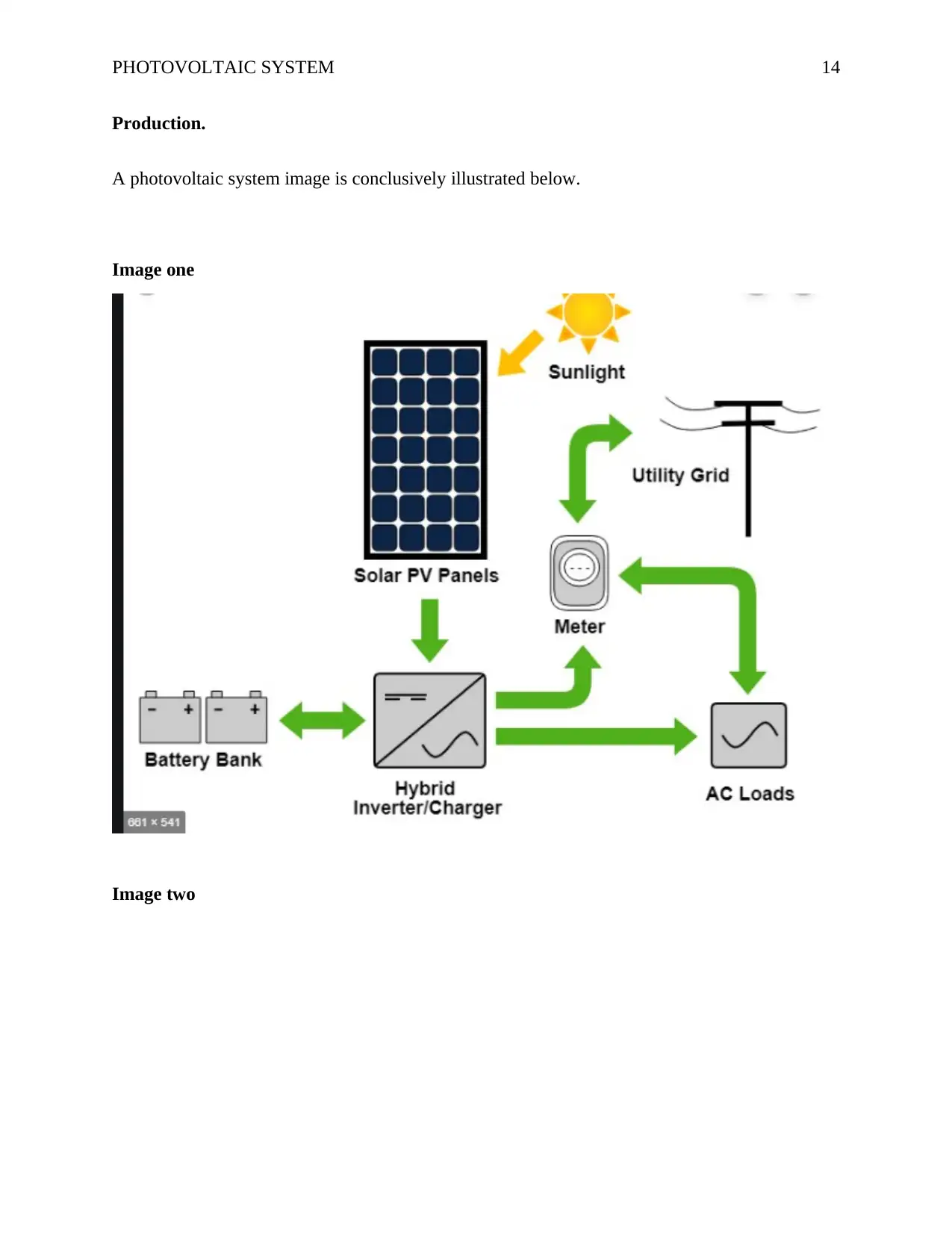
PHOTOVOLTAIC SYSTEM 14
Production.
A photovoltaic system image is conclusively illustrated below.
Image one
Image two
Production.
A photovoltaic system image is conclusively illustrated below.
Image one
Image two
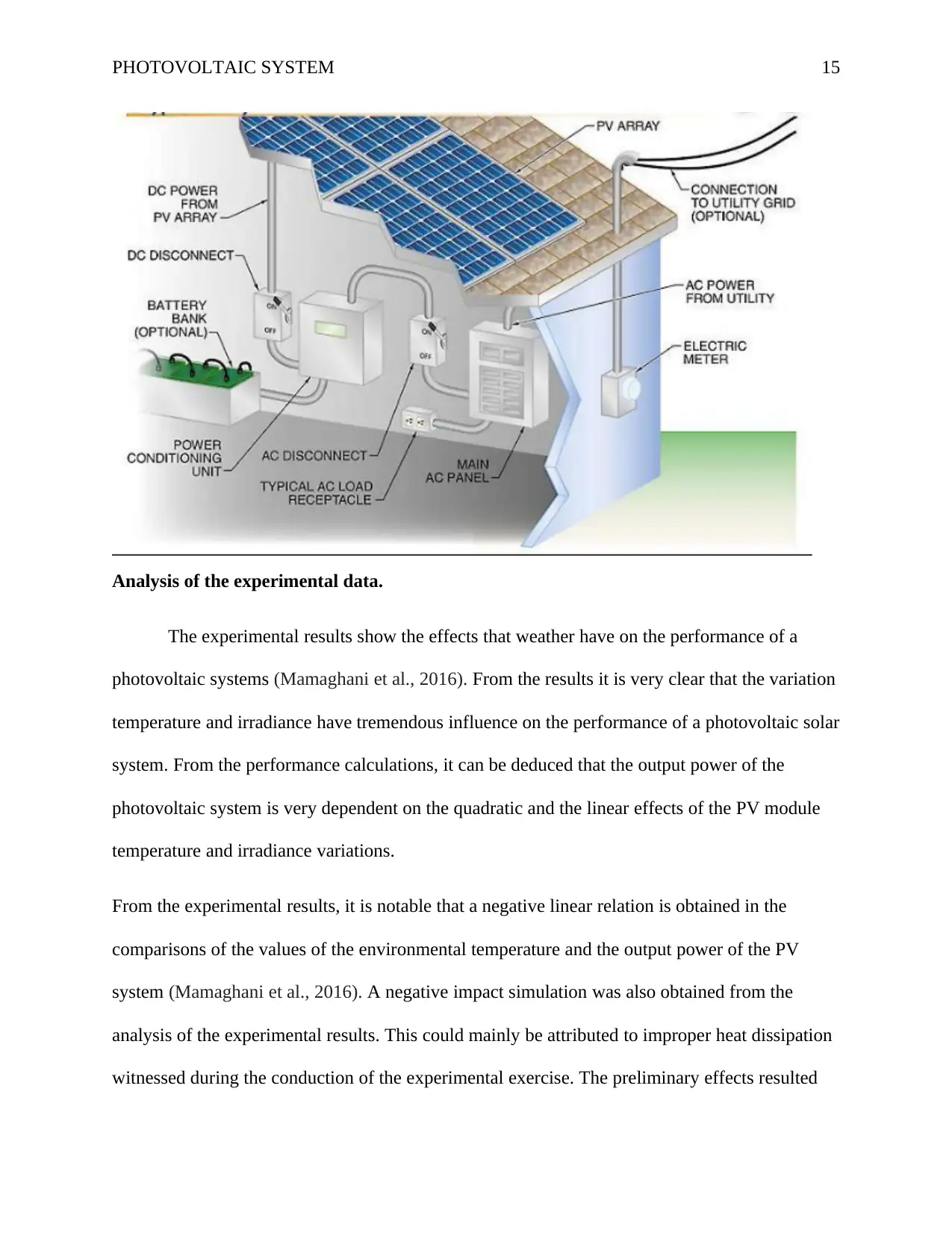
PHOTOVOLTAIC SYSTEM 15
Analysis of the experimental data.
The experimental results show the effects that weather have on the performance of a
photovoltaic systems (Mamaghani et al., 2016). From the results it is very clear that the variation
temperature and irradiance have tremendous influence on the performance of a photovoltaic solar
system. From the performance calculations, it can be deduced that the output power of the
photovoltaic system is very dependent on the quadratic and the linear effects of the PV module
temperature and irradiance variations.
From the experimental results, it is notable that a negative linear relation is obtained in the
comparisons of the values of the environmental temperature and the output power of the PV
system (Mamaghani et al., 2016). A negative impact simulation was also obtained from the
analysis of the experimental results. This could mainly be attributed to improper heat dissipation
witnessed during the conduction of the experimental exercise. The preliminary effects resulted
Analysis of the experimental data.
The experimental results show the effects that weather have on the performance of a
photovoltaic systems (Mamaghani et al., 2016). From the results it is very clear that the variation
temperature and irradiance have tremendous influence on the performance of a photovoltaic solar
system. From the performance calculations, it can be deduced that the output power of the
photovoltaic system is very dependent on the quadratic and the linear effects of the PV module
temperature and irradiance variations.
From the experimental results, it is notable that a negative linear relation is obtained in the
comparisons of the values of the environmental temperature and the output power of the PV
system (Mamaghani et al., 2016). A negative impact simulation was also obtained from the
analysis of the experimental results. This could mainly be attributed to improper heat dissipation
witnessed during the conduction of the experimental exercise. The preliminary effects resulted
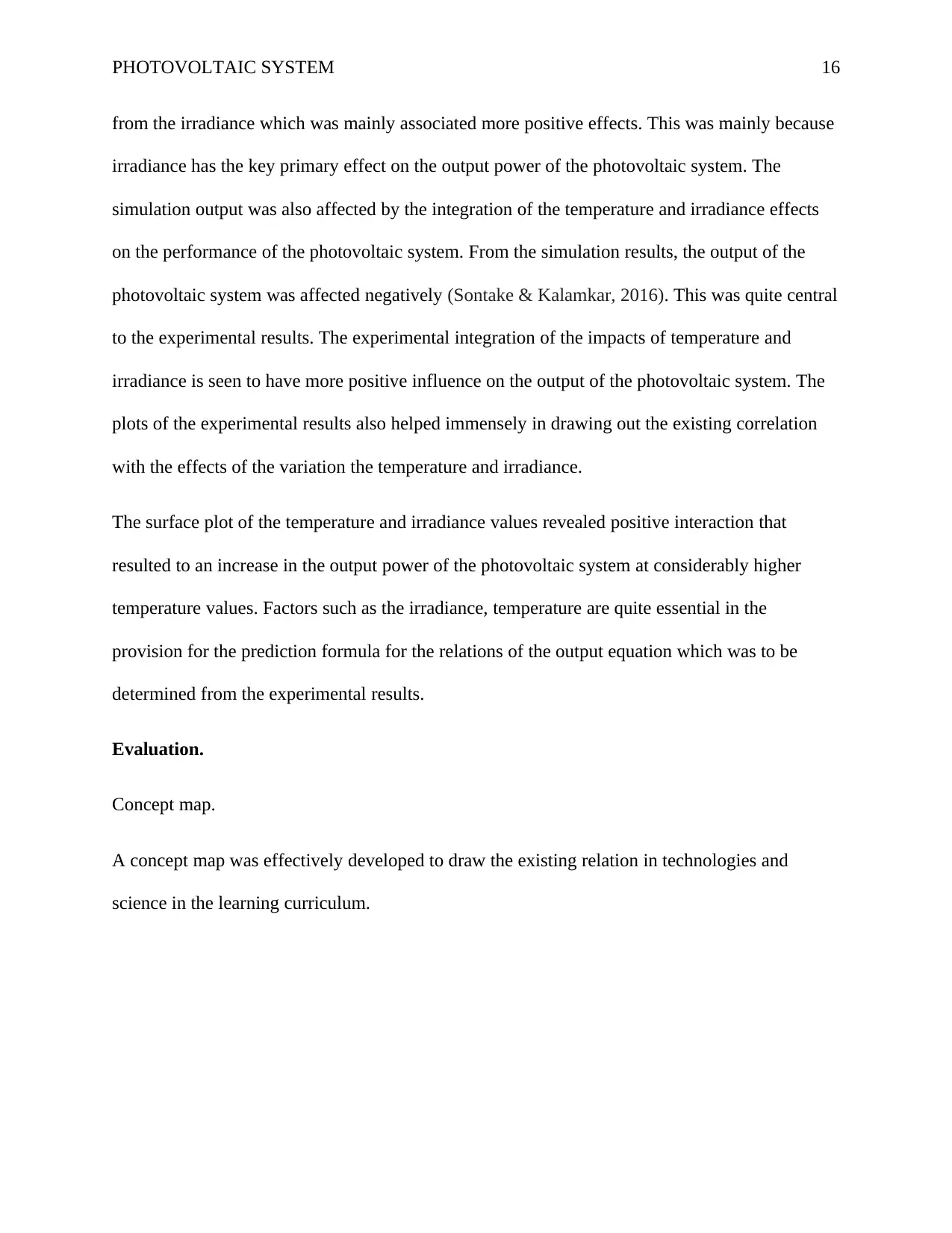
PHOTOVOLTAIC SYSTEM 16
from the irradiance which was mainly associated more positive effects. This was mainly because
irradiance has the key primary effect on the output power of the photovoltaic system. The
simulation output was also affected by the integration of the temperature and irradiance effects
on the performance of the photovoltaic system. From the simulation results, the output of the
photovoltaic system was affected negatively (Sontake & Kalamkar, 2016). This was quite central
to the experimental results. The experimental integration of the impacts of temperature and
irradiance is seen to have more positive influence on the output of the photovoltaic system. The
plots of the experimental results also helped immensely in drawing out the existing correlation
with the effects of the variation the temperature and irradiance.
The surface plot of the temperature and irradiance values revealed positive interaction that
resulted to an increase in the output power of the photovoltaic system at considerably higher
temperature values. Factors such as the irradiance, temperature are quite essential in the
provision for the prediction formula for the relations of the output equation which was to be
determined from the experimental results.
Evaluation.
Concept map.
A concept map was effectively developed to draw the existing relation in technologies and
science in the learning curriculum.
from the irradiance which was mainly associated more positive effects. This was mainly because
irradiance has the key primary effect on the output power of the photovoltaic system. The
simulation output was also affected by the integration of the temperature and irradiance effects
on the performance of the photovoltaic system. From the simulation results, the output of the
photovoltaic system was affected negatively (Sontake & Kalamkar, 2016). This was quite central
to the experimental results. The experimental integration of the impacts of temperature and
irradiance is seen to have more positive influence on the output of the photovoltaic system. The
plots of the experimental results also helped immensely in drawing out the existing correlation
with the effects of the variation the temperature and irradiance.
The surface plot of the temperature and irradiance values revealed positive interaction that
resulted to an increase in the output power of the photovoltaic system at considerably higher
temperature values. Factors such as the irradiance, temperature are quite essential in the
provision for the prediction formula for the relations of the output equation which was to be
determined from the experimental results.
Evaluation.
Concept map.
A concept map was effectively developed to draw the existing relation in technologies and
science in the learning curriculum.
Secure Best Marks with AI Grader
Need help grading? Try our AI Grader for instant feedback on your assignments.
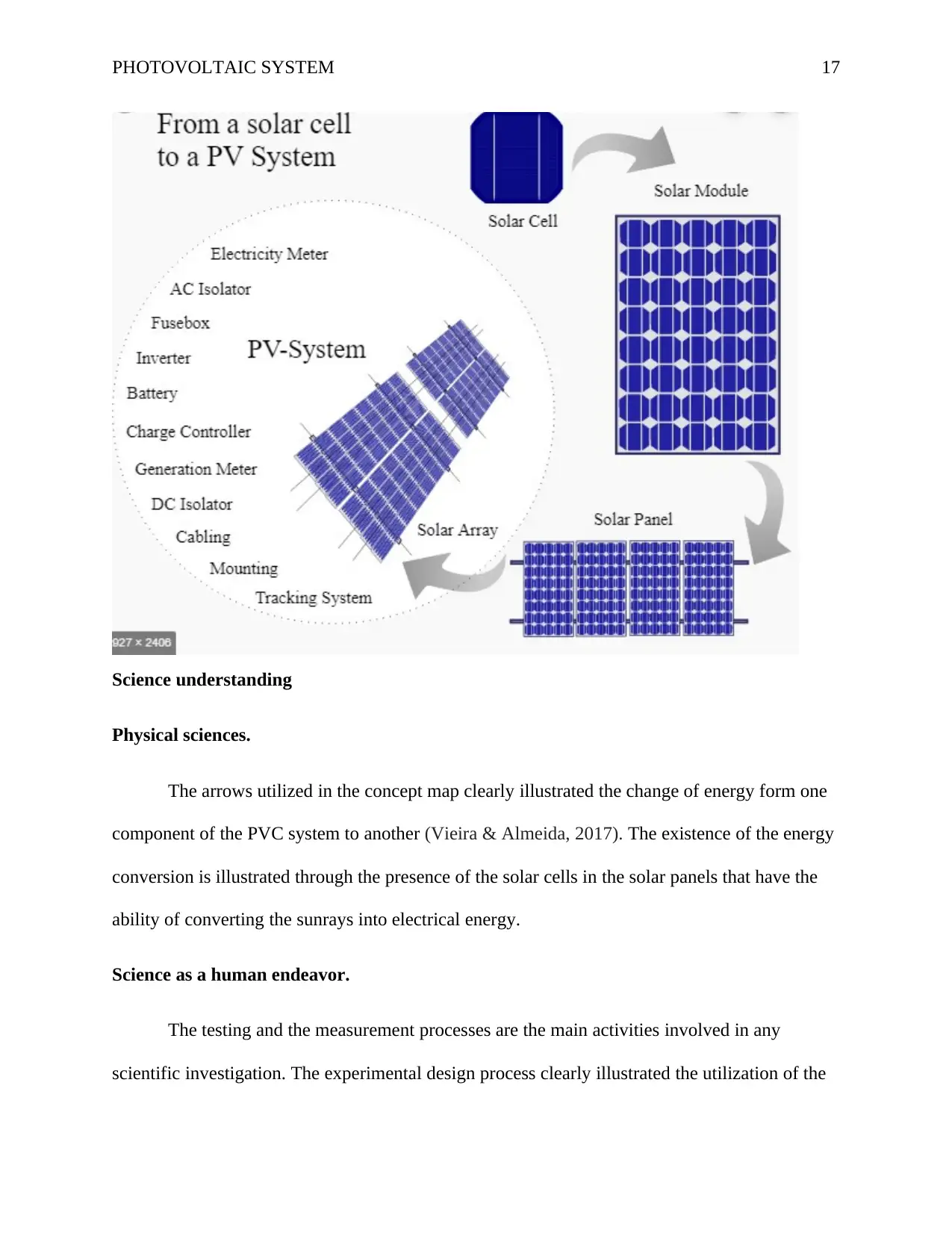
PHOTOVOLTAIC SYSTEM 17
Science understanding
Physical sciences.
The arrows utilized in the concept map clearly illustrated the change of energy form one
component of the PVC system to another (Vieira & Almeida, 2017). The existence of the energy
conversion is illustrated through the presence of the solar cells in the solar panels that have the
ability of converting the sunrays into electrical energy.
Science as a human endeavor.
The testing and the measurement processes are the main activities involved in any
scientific investigation. The experimental design process clearly illustrated the utilization of the
Science understanding
Physical sciences.
The arrows utilized in the concept map clearly illustrated the change of energy form one
component of the PVC system to another (Vieira & Almeida, 2017). The existence of the energy
conversion is illustrated through the presence of the solar cells in the solar panels that have the
ability of converting the sunrays into electrical energy.
Science as a human endeavor.
The testing and the measurement processes are the main activities involved in any
scientific investigation. The experimental design process clearly illustrated the utilization of the
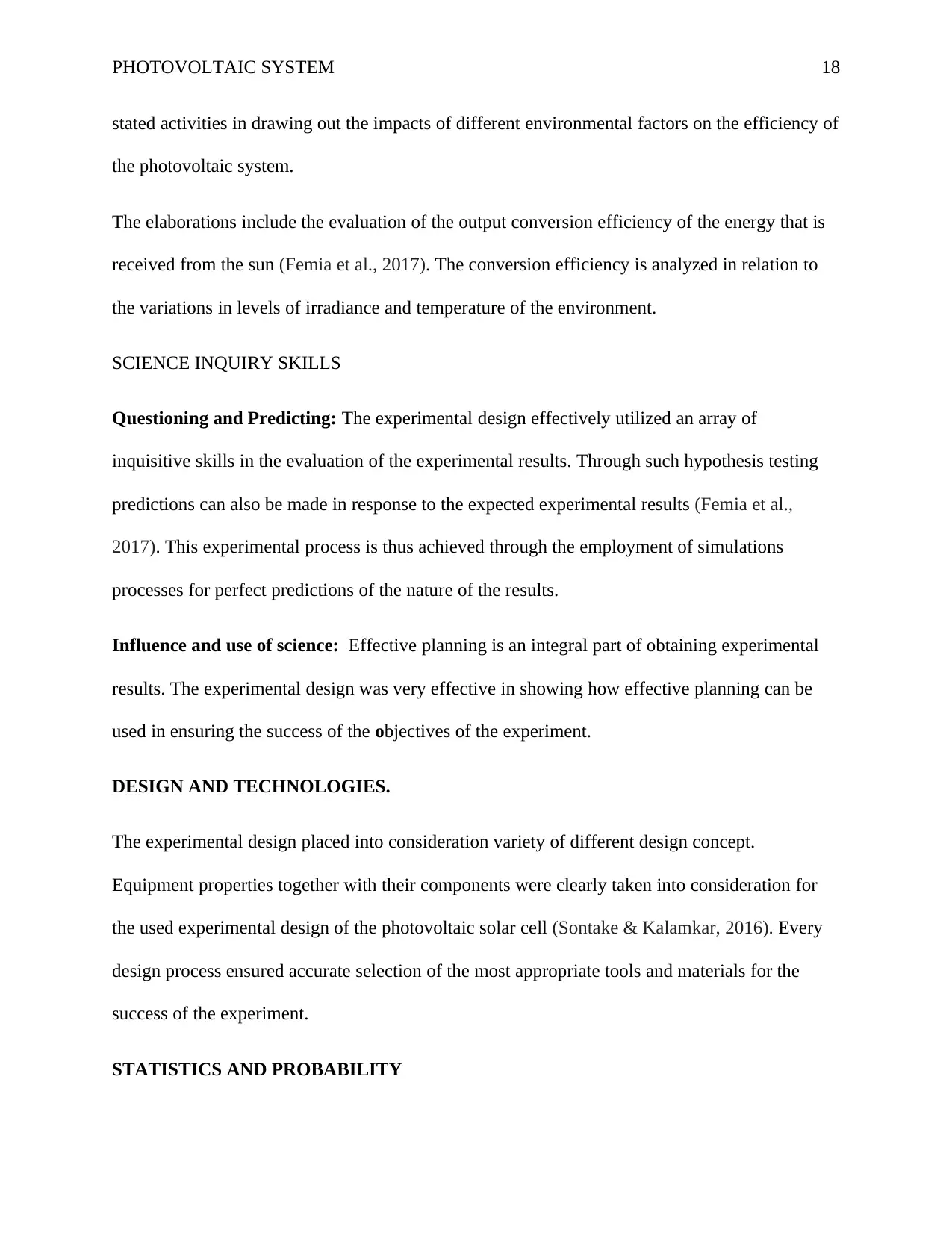
PHOTOVOLTAIC SYSTEM 18
stated activities in drawing out the impacts of different environmental factors on the efficiency of
the photovoltaic system.
The elaborations include the evaluation of the output conversion efficiency of the energy that is
received from the sun (Femia et al., 2017). The conversion efficiency is analyzed in relation to
the variations in levels of irradiance and temperature of the environment.
SCIENCE INQUIRY SKILLS
Questioning and Predicting: The experimental design effectively utilized an array of
inquisitive skills in the evaluation of the experimental results. Through such hypothesis testing
predictions can also be made in response to the expected experimental results (Femia et al.,
2017). This experimental process is thus achieved through the employment of simulations
processes for perfect predictions of the nature of the results.
Influence and use of science: Effective planning is an integral part of obtaining experimental
results. The experimental design was very effective in showing how effective planning can be
used in ensuring the success of the objectives of the experiment.
DESIGN AND TECHNOLOGIES.
The experimental design placed into consideration variety of different design concept.
Equipment properties together with their components were clearly taken into consideration for
the used experimental design of the photovoltaic solar cell (Sontake & Kalamkar, 2016). Every
design process ensured accurate selection of the most appropriate tools and materials for the
success of the experiment.
STATISTICS AND PROBABILITY
stated activities in drawing out the impacts of different environmental factors on the efficiency of
the photovoltaic system.
The elaborations include the evaluation of the output conversion efficiency of the energy that is
received from the sun (Femia et al., 2017). The conversion efficiency is analyzed in relation to
the variations in levels of irradiance and temperature of the environment.
SCIENCE INQUIRY SKILLS
Questioning and Predicting: The experimental design effectively utilized an array of
inquisitive skills in the evaluation of the experimental results. Through such hypothesis testing
predictions can also be made in response to the expected experimental results (Femia et al.,
2017). This experimental process is thus achieved through the employment of simulations
processes for perfect predictions of the nature of the results.
Influence and use of science: Effective planning is an integral part of obtaining experimental
results. The experimental design was very effective in showing how effective planning can be
used in ensuring the success of the objectives of the experiment.
DESIGN AND TECHNOLOGIES.
The experimental design placed into consideration variety of different design concept.
Equipment properties together with their components were clearly taken into consideration for
the used experimental design of the photovoltaic solar cell (Sontake & Kalamkar, 2016). Every
design process ensured accurate selection of the most appropriate tools and materials for the
success of the experiment.
STATISTICS AND PROBABILITY
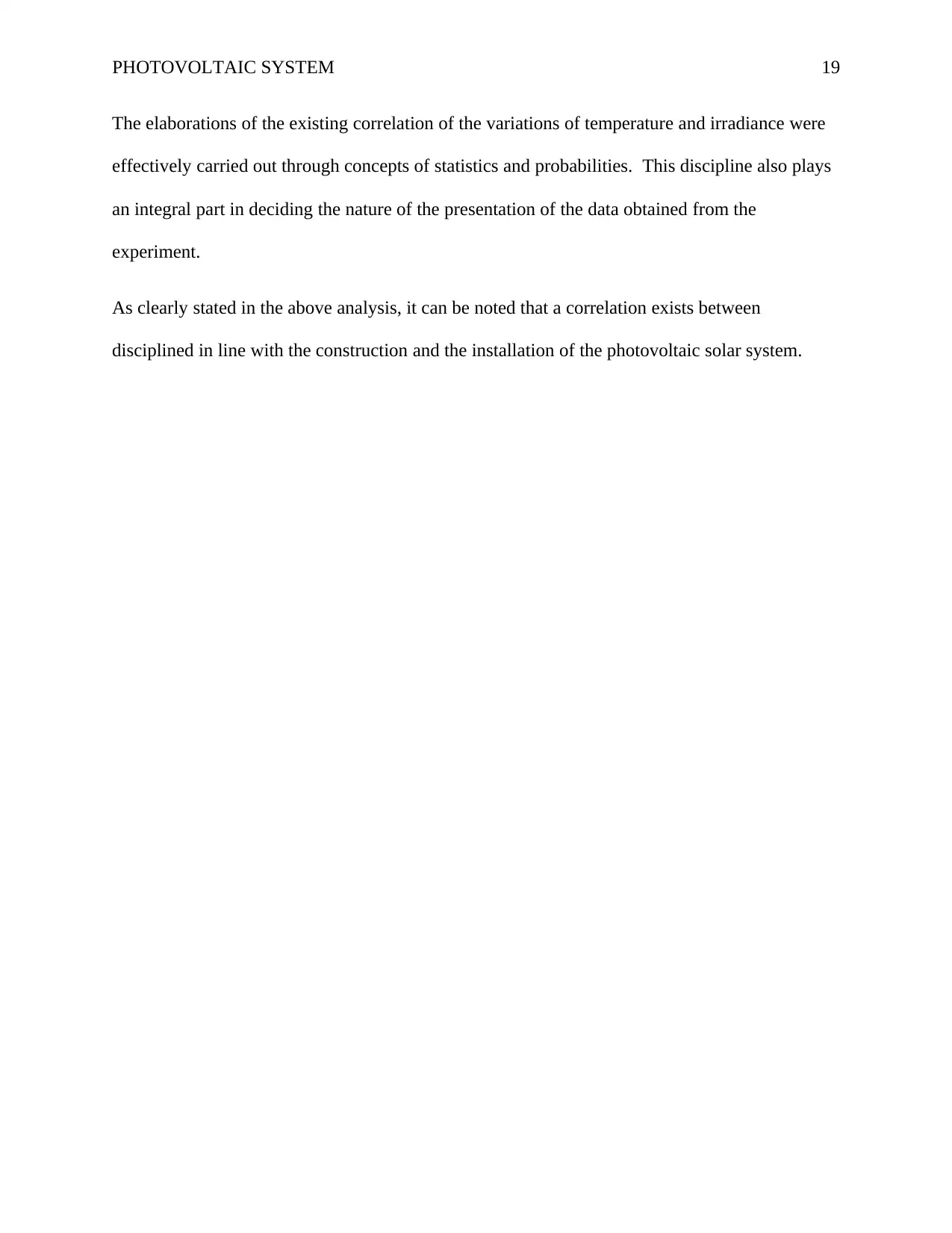
PHOTOVOLTAIC SYSTEM 19
The elaborations of the existing correlation of the variations of temperature and irradiance were
effectively carried out through concepts of statistics and probabilities. This discipline also plays
an integral part in deciding the nature of the presentation of the data obtained from the
experiment.
As clearly stated in the above analysis, it can be noted that a correlation exists between
disciplined in line with the construction and the installation of the photovoltaic solar system.
The elaborations of the existing correlation of the variations of temperature and irradiance were
effectively carried out through concepts of statistics and probabilities. This discipline also plays
an integral part in deciding the nature of the presentation of the data obtained from the
experiment.
As clearly stated in the above analysis, it can be noted that a correlation exists between
disciplined in line with the construction and the installation of the photovoltaic solar system.
Paraphrase This Document
Need a fresh take? Get an instant paraphrase of this document with our AI Paraphraser
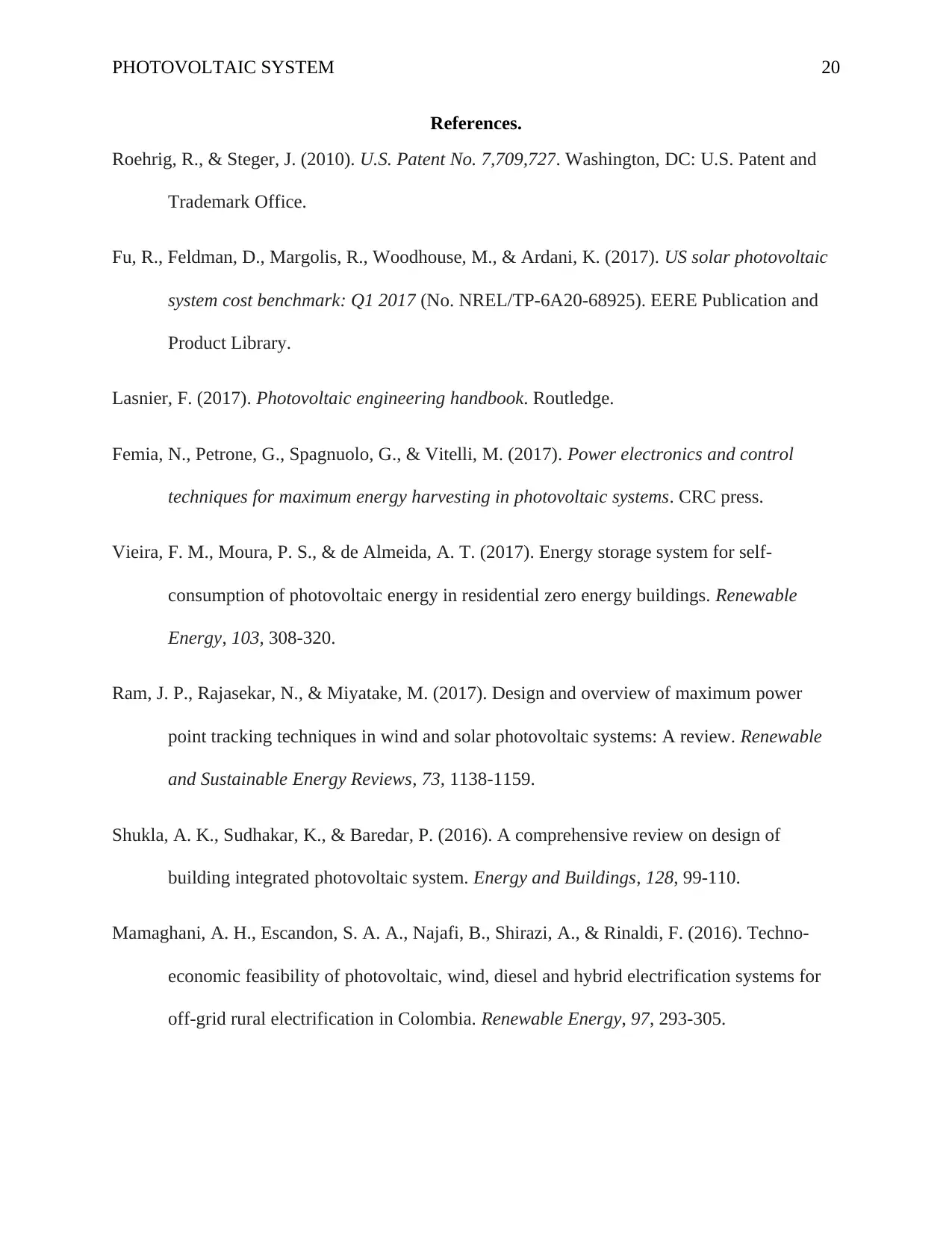
PHOTOVOLTAIC SYSTEM 20
References.
Roehrig, R., & Steger, J. (2010). U.S. Patent No. 7,709,727. Washington, DC: U.S. Patent and
Trademark Office.
Fu, R., Feldman, D., Margolis, R., Woodhouse, M., & Ardani, K. (2017). US solar photovoltaic
system cost benchmark: Q1 2017 (No. NREL/TP-6A20-68925). EERE Publication and
Product Library.
Lasnier, F. (2017). Photovoltaic engineering handbook. Routledge.
Femia, N., Petrone, G., Spagnuolo, G., & Vitelli, M. (2017). Power electronics and control
techniques for maximum energy harvesting in photovoltaic systems. CRC press.
Vieira, F. M., Moura, P. S., & de Almeida, A. T. (2017). Energy storage system for self-
consumption of photovoltaic energy in residential zero energy buildings. Renewable
Energy, 103, 308-320.
Ram, J. P., Rajasekar, N., & Miyatake, M. (2017). Design and overview of maximum power
point tracking techniques in wind and solar photovoltaic systems: A review. Renewable
and Sustainable Energy Reviews, 73, 1138-1159.
Shukla, A. K., Sudhakar, K., & Baredar, P. (2016). A comprehensive review on design of
building integrated photovoltaic system. Energy and Buildings, 128, 99-110.
Mamaghani, A. H., Escandon, S. A. A., Najafi, B., Shirazi, A., & Rinaldi, F. (2016). Techno-
economic feasibility of photovoltaic, wind, diesel and hybrid electrification systems for
off-grid rural electrification in Colombia. Renewable Energy, 97, 293-305.
References.
Roehrig, R., & Steger, J. (2010). U.S. Patent No. 7,709,727. Washington, DC: U.S. Patent and
Trademark Office.
Fu, R., Feldman, D., Margolis, R., Woodhouse, M., & Ardani, K. (2017). US solar photovoltaic
system cost benchmark: Q1 2017 (No. NREL/TP-6A20-68925). EERE Publication and
Product Library.
Lasnier, F. (2017). Photovoltaic engineering handbook. Routledge.
Femia, N., Petrone, G., Spagnuolo, G., & Vitelli, M. (2017). Power electronics and control
techniques for maximum energy harvesting in photovoltaic systems. CRC press.
Vieira, F. M., Moura, P. S., & de Almeida, A. T. (2017). Energy storage system for self-
consumption of photovoltaic energy in residential zero energy buildings. Renewable
Energy, 103, 308-320.
Ram, J. P., Rajasekar, N., & Miyatake, M. (2017). Design and overview of maximum power
point tracking techniques in wind and solar photovoltaic systems: A review. Renewable
and Sustainable Energy Reviews, 73, 1138-1159.
Shukla, A. K., Sudhakar, K., & Baredar, P. (2016). A comprehensive review on design of
building integrated photovoltaic system. Energy and Buildings, 128, 99-110.
Mamaghani, A. H., Escandon, S. A. A., Najafi, B., Shirazi, A., & Rinaldi, F. (2016). Techno-
economic feasibility of photovoltaic, wind, diesel and hybrid electrification systems for
off-grid rural electrification in Colombia. Renewable Energy, 97, 293-305.
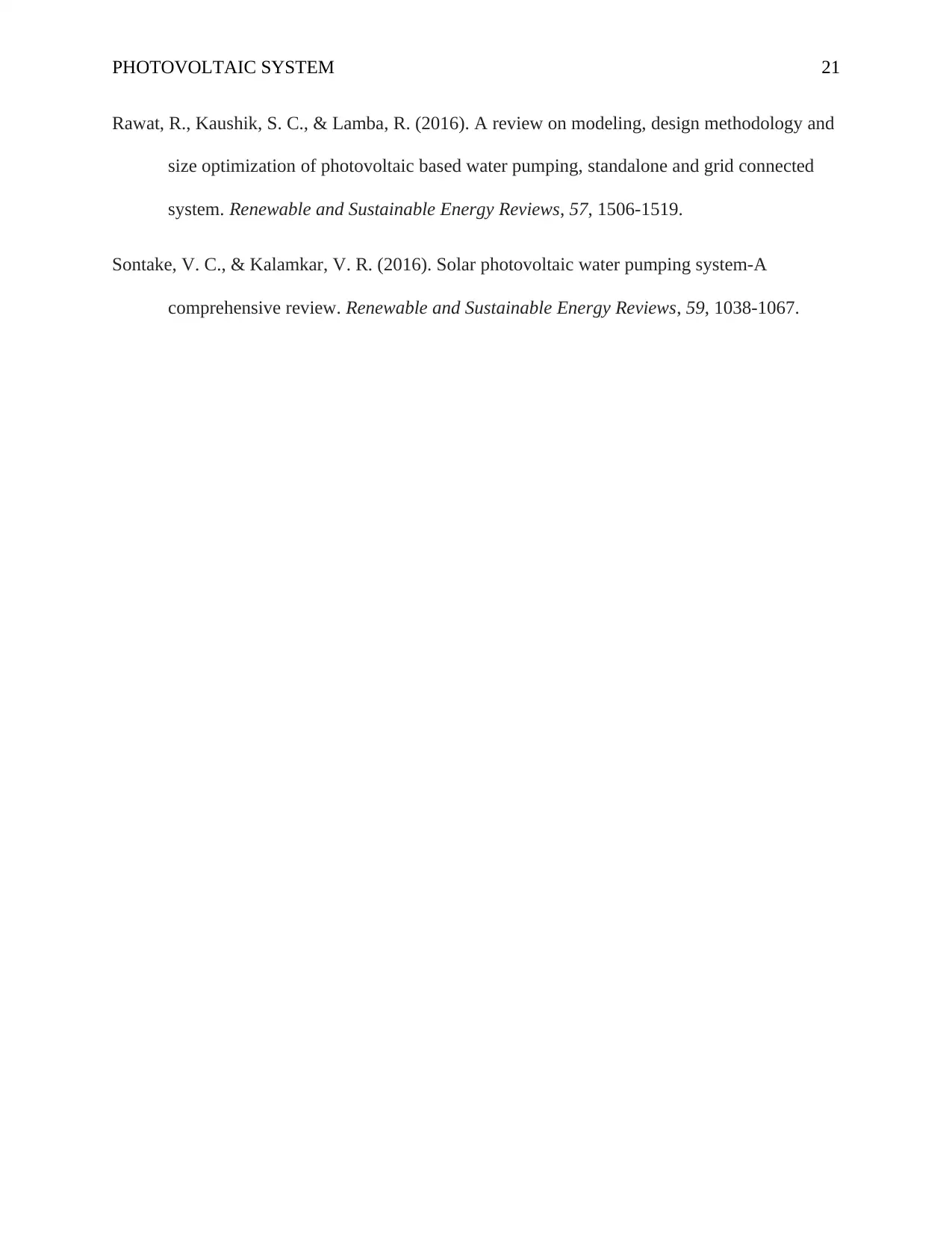
PHOTOVOLTAIC SYSTEM 21
Rawat, R., Kaushik, S. C., & Lamba, R. (2016). A review on modeling, design methodology and
size optimization of photovoltaic based water pumping, standalone and grid connected
system. Renewable and Sustainable Energy Reviews, 57, 1506-1519.
Sontake, V. C., & Kalamkar, V. R. (2016). Solar photovoltaic water pumping system-A
comprehensive review. Renewable and Sustainable Energy Reviews, 59, 1038-1067.
Rawat, R., Kaushik, S. C., & Lamba, R. (2016). A review on modeling, design methodology and
size optimization of photovoltaic based water pumping, standalone and grid connected
system. Renewable and Sustainable Energy Reviews, 57, 1506-1519.
Sontake, V. C., & Kalamkar, V. R. (2016). Solar photovoltaic water pumping system-A
comprehensive review. Renewable and Sustainable Energy Reviews, 59, 1038-1067.
1 out of 21
Related Documents
Your All-in-One AI-Powered Toolkit for Academic Success.
+13062052269
info@desklib.com
Available 24*7 on WhatsApp / Email
![[object Object]](/_next/static/media/star-bottom.7253800d.svg)
Unlock your academic potential
© 2024 | Zucol Services PVT LTD | All rights reserved.





